When dining, you’re going to want to enjoy yourself, and the people you’re with, but with etiquette varying across continents, it’s easy to get confused. In this guide, we talk about how to eat with a fork and knife properly so you don’t embarrass yourself and can focus on the company you have tableside.
If you’re curious about table manners as a whole, you can check out our table manners guide.
Table Manners – Ultimate Guide to Dining Etiquette
Today, we mainly focus on fork and knife, the different options you have, exceptions to the rules, do’s and don’ts, as well as the historic background of how things evolved the way they did.
We’ll start by explaining the different ways how you can hold a fork and knife. Basically, there is the Continental Style, which dominates in Europe, their adaptations in Britain, and other parts of the world; and then there is the US or Northern American Style, which is somewhat different. Within those styles, there are differences, too, and we’ll cover those as well.
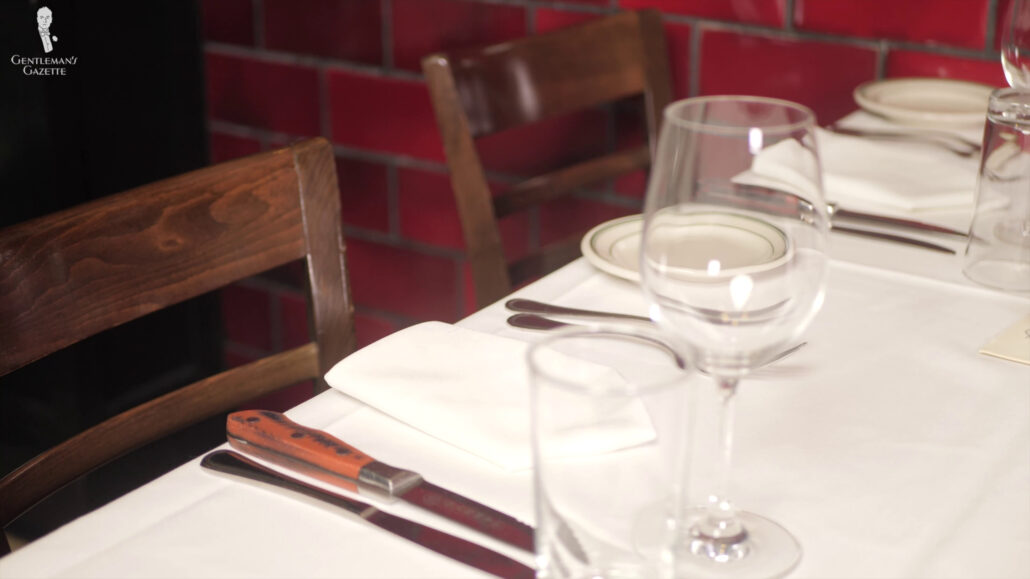
As a quick note, keep in mind that, traditionally, cutlery etiquette was based on the right hand and the left hand, and there was no variation. In this day and age, it’s more about the dominant hand and the non-dominant hand.
Back in the day, lefties had to learn to do everything in the same way as right-handed people did. Today, that’s no longer the case, and that’s a good thing.
American (Zig-Zag) Style
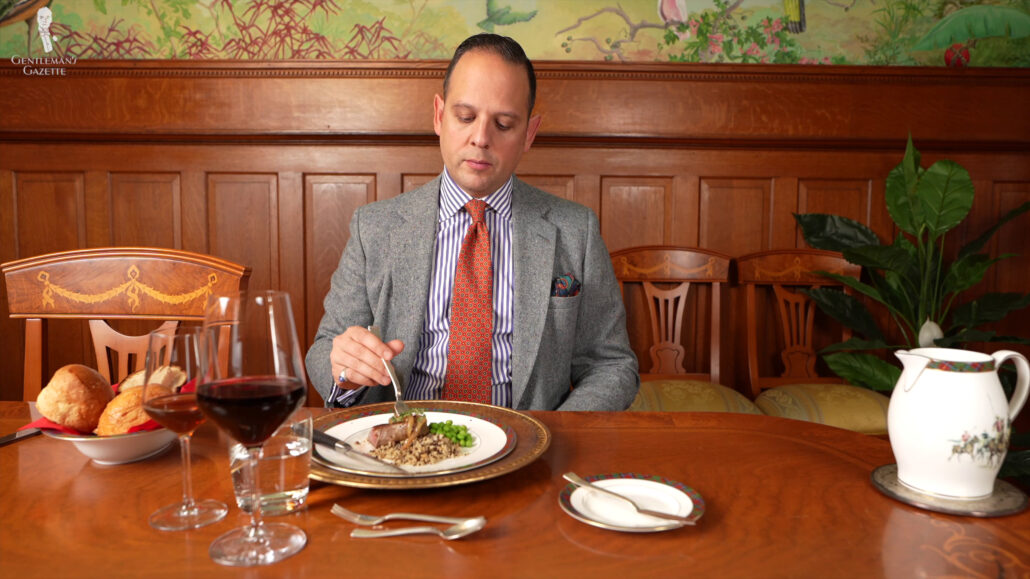
Since we’re based in the US, let’s start with the American or “Zigzag Style.” In the 1946, World War II spy movie “OSS,” an American agent is identified by the way they eat. As you might know from “Inglorious Basterds,” the way you count with your fingers, they also identify you as being on one side or the other. But, in this spy movie, they really focused on table manners. If you think about it, it truly indicates how closely this style is associated with the United States of America.
So, what’s the American Style? At the core, it means that you eat the majority of your food with your dominant hand and your fork only. While you eat with your dominant hand, your other hand rests on your lap or underneath the table. In Europe, that wouldn’t be considered proper at all.
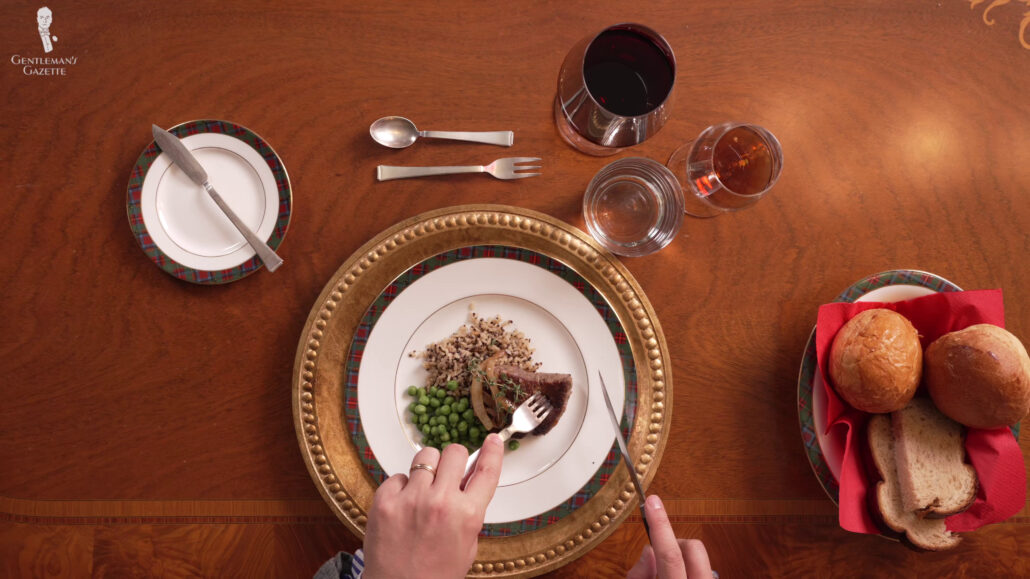
So, what does the American Style look like? Basically, you hold the fork in your dominant hand, and you only move it to a non-dominant hand when you cut. So, let’s say, for a steak: your fork moves to the non-dominant hand, you cut, you put the knife down, you switch hands, and you eat the piece of meat. If you want to cut another piece, you repeat the procedure again. So, the fork goes back and forth, back and forth, hence the term “Zigzag Style.”
Now, let’s take a look at the details. The fork is held similarly to a pencil. The shank is extended between your thumb, index, and middle finger. The hand is curved gently around the handle, and the tines are pointing upwards. No, you should not grip the fork tightly. It should rest gently in your hand, but it should be secure enough that it doesn’t just fall out of your hand.
When you now eat, you gently slide under whatever it is that you eat, or if it’s something firmer like a piece of meat for example, you can pierce the meat. Now, piercing can happen in one of two ways. Either you keep the tines exactly the way you hold a fork, facing upwards; or before you pierce it, you switch and you have the tines facing downward – that allows you to put a bit more pressure with your index finger and some people prefer that. Then, you lift the food to your mouth.
Again, the tines face up should be somewhat parallel to the plate, and you insert the fork into your mouth. You eat with your mouth closed, not making any noticeable noises.
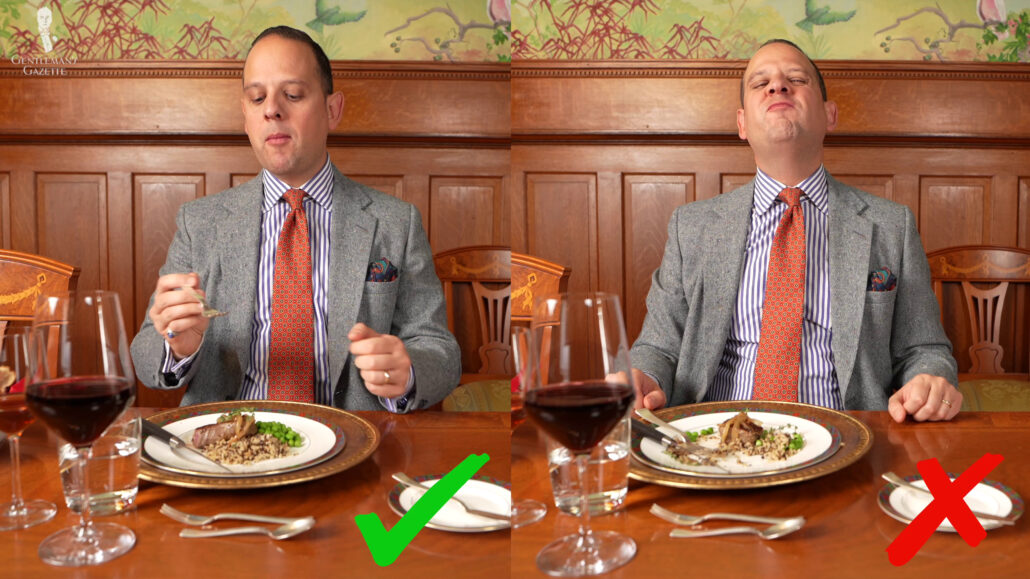
You can see, if you rotate your fork so your tines face downward just before piercing, you have to elegantly switch the fork back just before you eat.
When you cut something, you transfer the fork to your non-dominant hand with the tines facing down. You hold it with your index finger pushing down – that gives you a little more leverage and the ability to apply pressure, which is very helpful when cutting.
Your dominant hand takes the knife with the handle in your palm. As you can see, the handle should be cradled in your palm. The index finger should be slightly extended, resting on top of the base of the blade and pushing down, which gives you that control that you want when cutting. The middle, ring, and pinky finger are curved around the handle. Lightly pierce the food with a fork first, and then start cutting. Make sure the tines are rotated downwards, and you hold the fork in the proper way. Grabbing it with your entire hand is something four-year-olds do.
When you cut, do so in slow steady strokes. Not too fast, but not too slow either. When you’re finished cutting, place your knife on the plate, blade facing inwards of the plate, wherever you have space. Typically, that’s at the top of the blade at an angle, like so. Transfer your fork to your dominant hand again, pencil grip, and eat. Again, you can pierce it tines up or tines down. What matters is that the tines are up when you put it in your mouth.
In terms of size, you don’t want to have a huge piece that you stuff in your mouth that forces you to keep your mouth open. You also don’t want it to be too tiny.
Also, keep in mind that the fork moves toward your mouth. It’s not the other way around. You also don’t want to meet somewhere in between. It’s easiest to do that if you sit upright and you keep the non-dominant, non-occupied hand on your lap. In the US, it’s not considered polite to have your elbows resting on the table or your forearms. If you want to pause eating or go to the restroom, you can keep your utensils on your plate. More about that later.
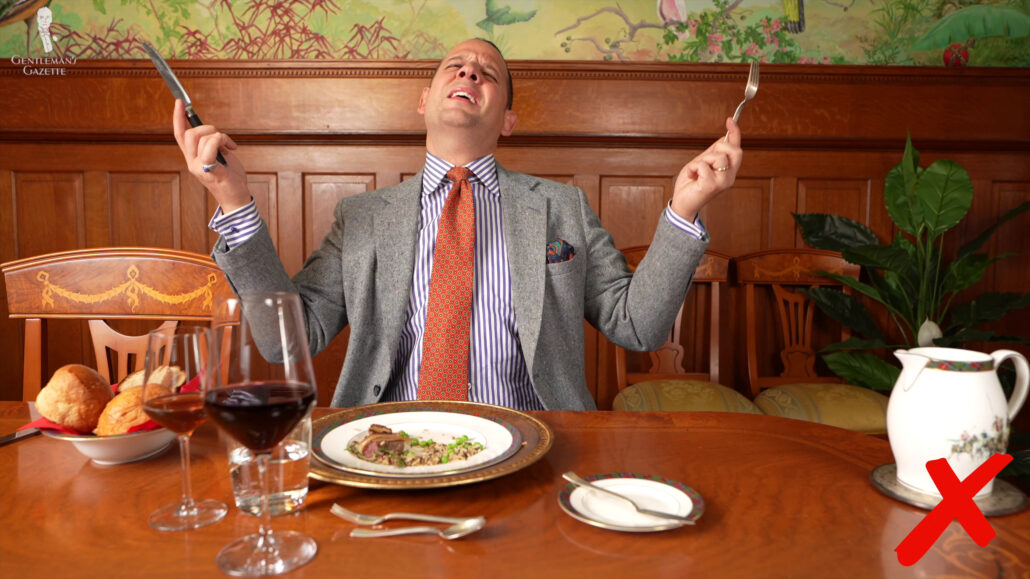
When you’re in a conversation and you use your hands to gesture, always make sure that you put your utensils and silver down first. You never want to gesture with your fork and or your knife in your hand.
Why? Well, with your silver in your hand, you have an extension, so your gestures become more extreme, and you may hit a glass or, even worse, someone, at your table.
Continental (European) Style
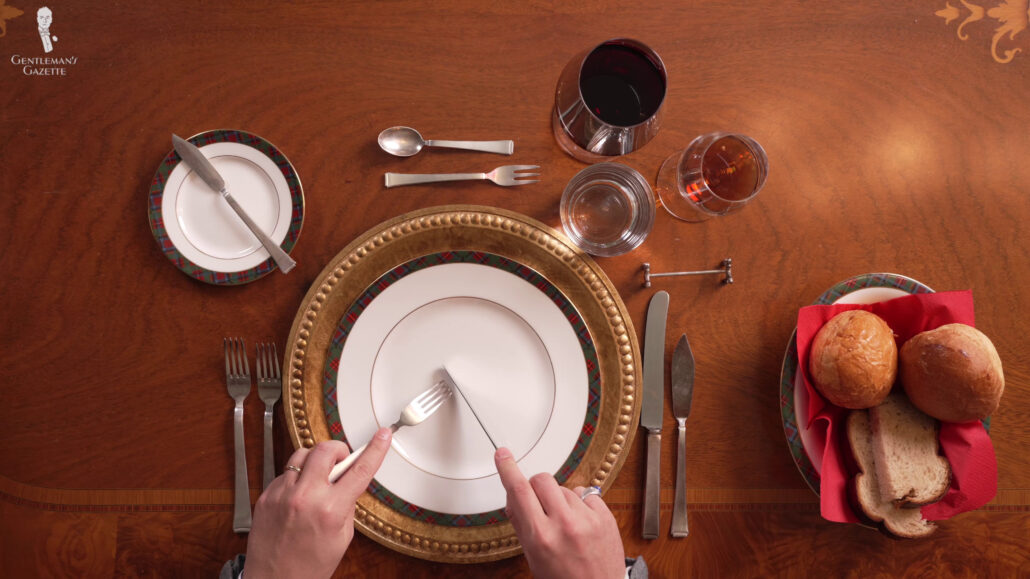
What’s the Continental or European Style, then? Even though it’s called that way, it’s used in most parts of the world, except, of course, the US. The important difference is that both the fork and the knife are held in both hands throughout the meal.
So, for the knife, just like with the American method, the handle should be cradled in your palm. The index finger should be slightly extended, resting on top of the base of the plate to give you that pressure and controllability. Your middle finger, ring finger, and pinky are just curved around the handle. The fork is held in a non-dominant offhand.
A fork can be held in one of two ways. When the tines face upward, you hold it in the pencil grip. This is the exact same grip as in the American Style. It’s just in the non-dominant offhand.
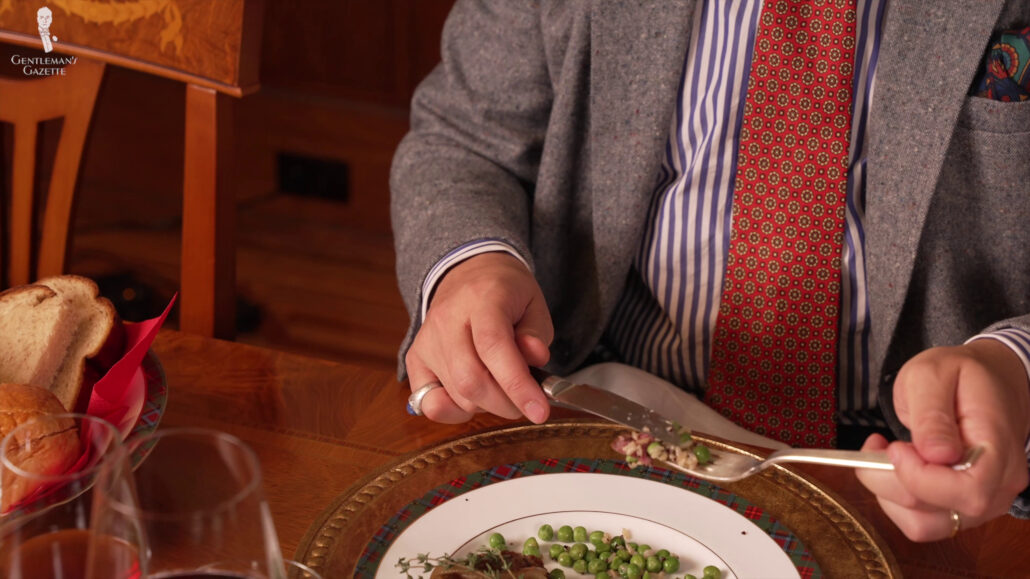
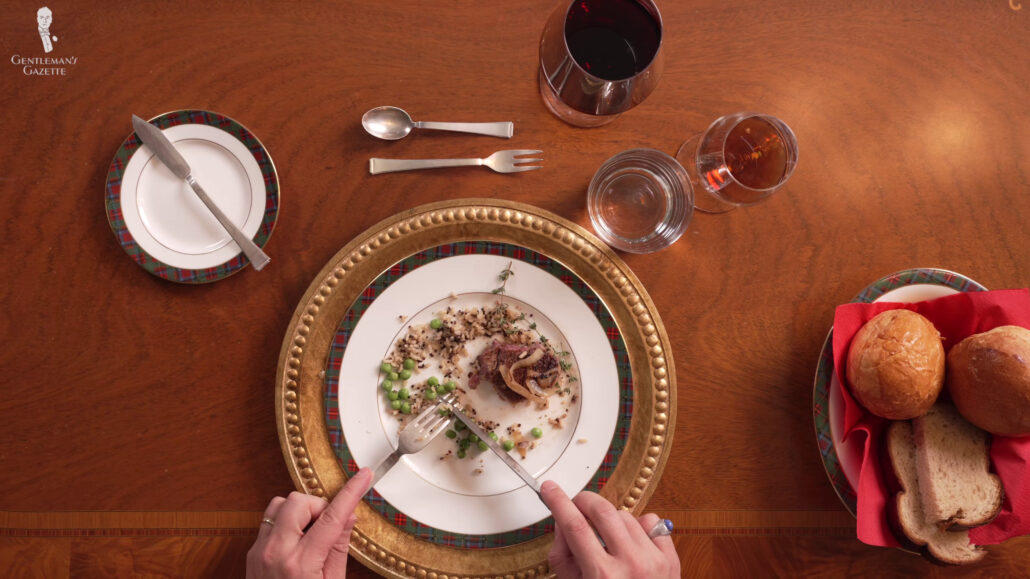
The other option is to hold the fork tines down with the index finger extended, allowing you to push down when needed. Again, you hold it between the thumb and your middle, ring, and pinky finger. The index finger rests on the handle of the fork, not too far forward. It’s also called “The Hidden Handle” because the handle of the fork is covered by your hand.
When you eat, you sit up straight, your forearms are slightly extended, but close to your body. You don’t want your elbows to go sideways, especially on a table where there’s not much space. You never want to touch your neighbor with your arms when you cut or eat. Your forearms are not resting on the table.
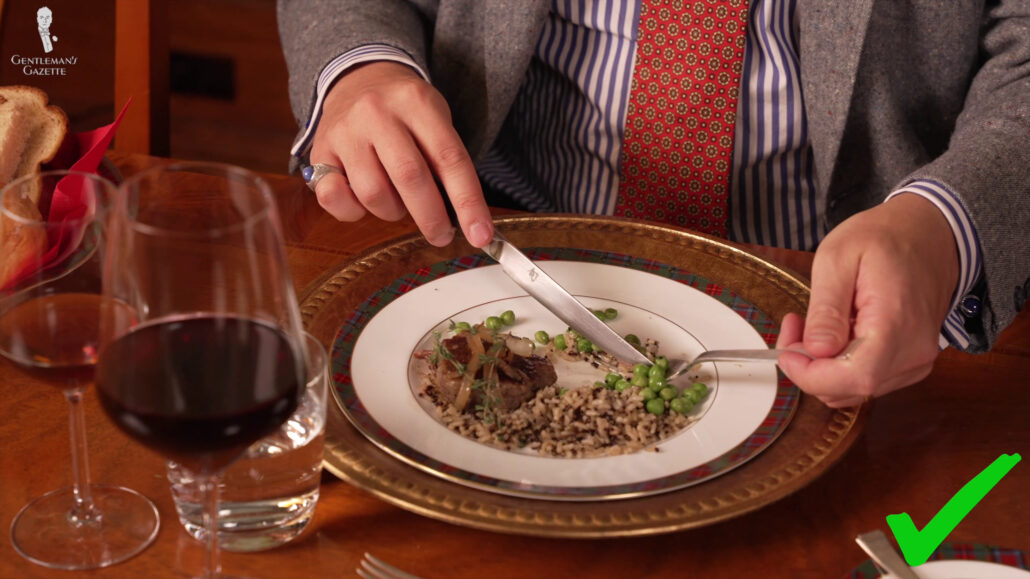
Try to keep your forearms steady in the elbows tucked in, but it should still seem effortless and comfortable, not too cramped. Most of your motions will come from your elbow and your wrist. Avoid any large, long strokes with your arms or elbows. If you eat your food, again, there are two ways, depending on if your fork tines are facing downwards or upwards.
If your tines face upwards, you can gently slide your fork under the food, and then move it to your mouth with the tines facing upwards. Alternatively, you can use the blade in your dominant hand to help shove the food onto the fork and then move your fork to the mouth. The same rules apply here as in the US; the fork moves to your mouth, and your mouth doesn’t move to the fork.
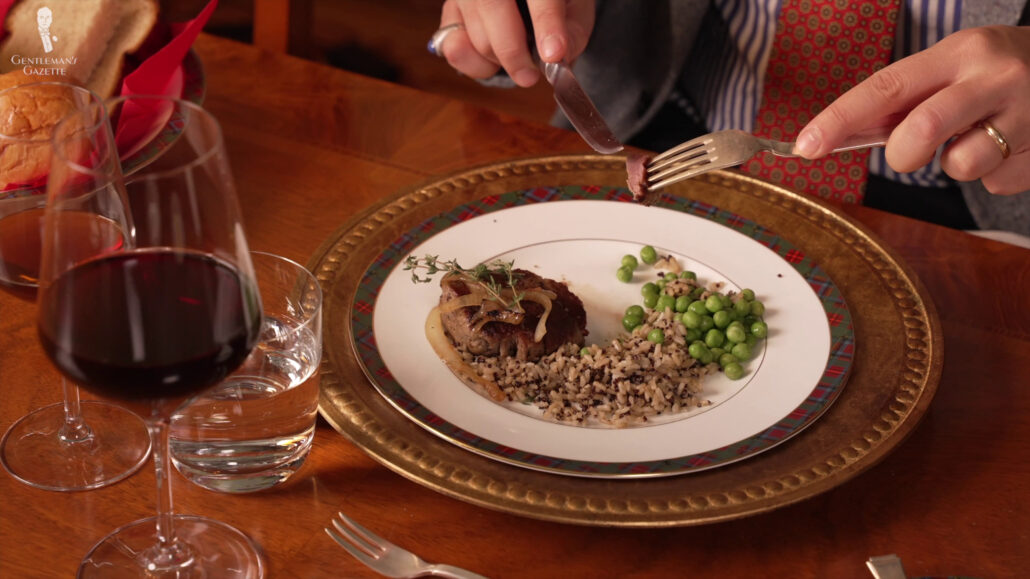
If you’re in Great Britain, many people will eat with the tines facing down. In that case, the food is also applied with a knife onto the fork, and then, with the tines facing downwards, it is moved into your mouth.
Reading through the comments in our table manners video, some people argued that eating with your fork tines facing up is a faux pas, and it reminded them of eating with a pitchfork. Maybe this is the case in certain areas in the UK, but in most parts of Europe and the world, it is absolutely 100% acceptable to eat with the tines facing up.
When you cut your food Continental Style, the tines will always face down. Again, the index finger is there to apply pressure downwards on the fork and on the knife. Place the fork in a shallow angle, pierce the food, and use slow but steady cutting motions back and forth. Once you’ve done so, you can move the cut-off piece – let’s say, meat – to your mouth and eat it.
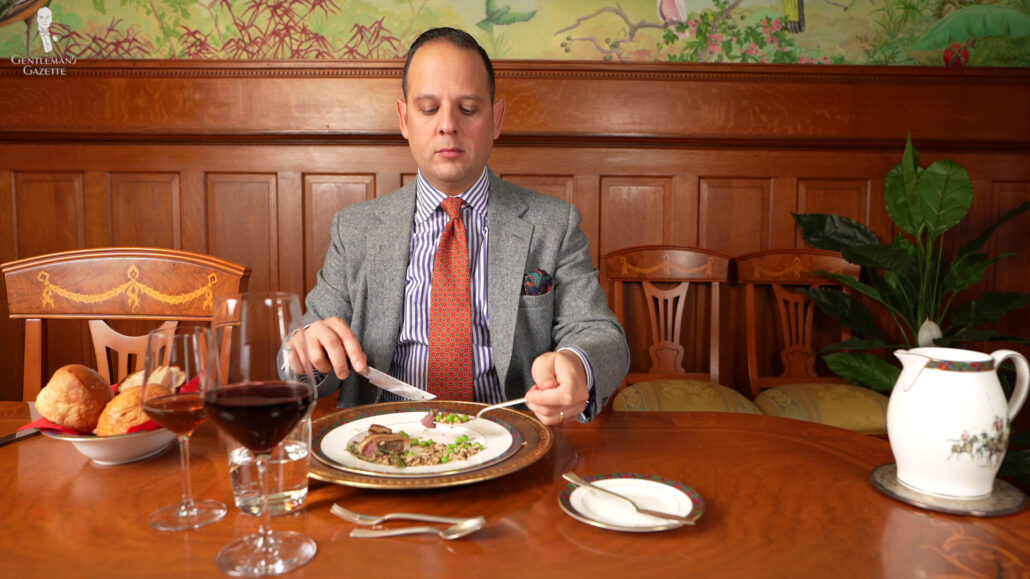
Again, in Britain, the tines will face down and remain face down, and the food will go to your mouth. For example, in Germany, you will elegantly rotate your fork and bring the meat – tines facing up – to your mouth.
Which Style Is Better: American or Continental?
Some people may argue that the American Style is easier to learn and to handle. Personally, I think it’s all just a matter of practice and training. At the end of the day, the Zigzag Style is more time-consuming, and it seems less elegant to me. But, I also grew up in Germany, where I learned the Continental Style, so I may be biased.
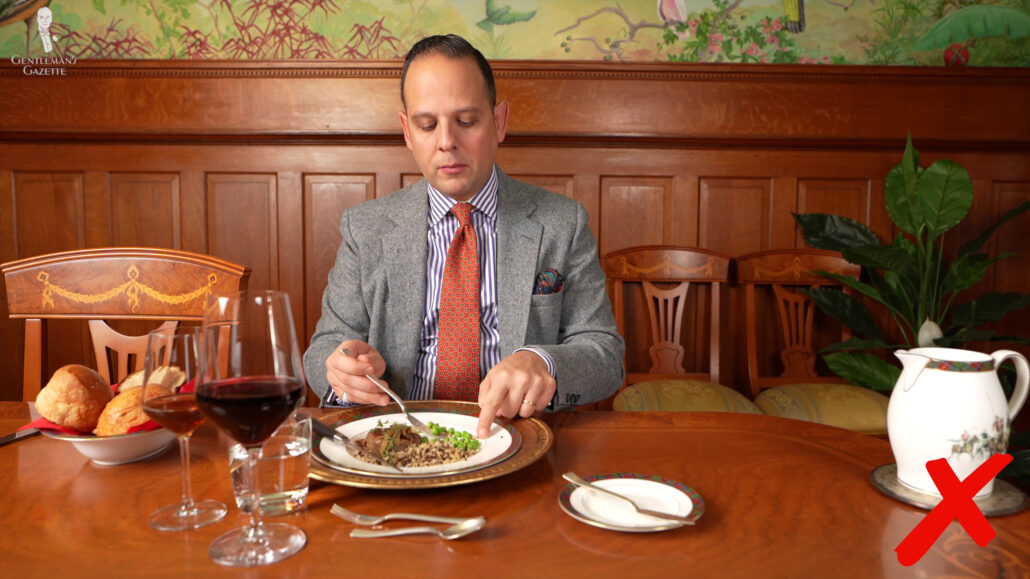
In our opinion, the biggest drawback of the American method is getting food onto your fork, and I regularly see people using their fingers to place things on their fork when they eat it. In my mind, it’s a lot more elegant. Your hands stay clean and sanitary if you just use your knife to move things onto your fork.
Again, there are two different options – like so, when the time stays up, and this way if the tines face down. Also, I think the Continental Style looks more elegant because you always have the fork and a knife in your hand, and, in my mind, it’s a lot easier.
Some people say it’s hard for kids. My daughter has been using her fork and knife since she was three years old. And she’s five now, and I think she has better knife and fork skills than some grown-ups I see sometimes.
Ultimately, the choice of which style you choose is entirely yours; however, if you’re switching styles or if you’re planning to up your table manner game, I suggest you practice at home, so you become really comfortable, and it’s all second nature.
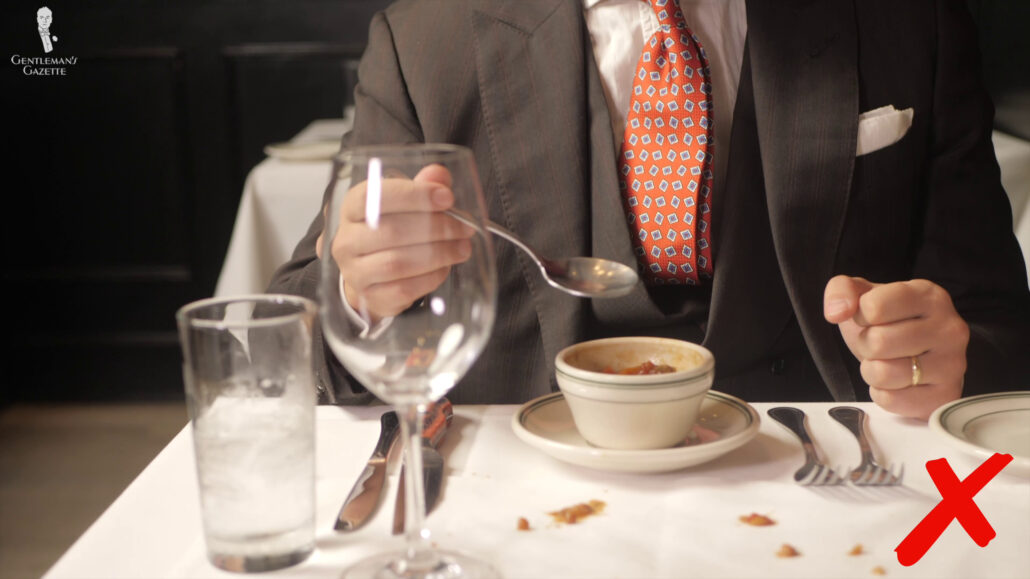
The last thing you want is to be intensely focused on your fork and knife skills when you’re in company, and you can’t really focus your attention on the people at your table. Also, if you’re a clotheshorse like me, it would be terrible if your food accidentally ends up on your clothes.
So, at the end of the day, you might be better off employing the style that you’re more comfortable with than the one that is less familiar to you, even though it might seem more debonair.
Resting Your Fork & Knife
First of all, what should you do when you’re not actively cutting, scooping, or eating with it? Again, it depends on the style and whether your dominant hand is a right or a left.
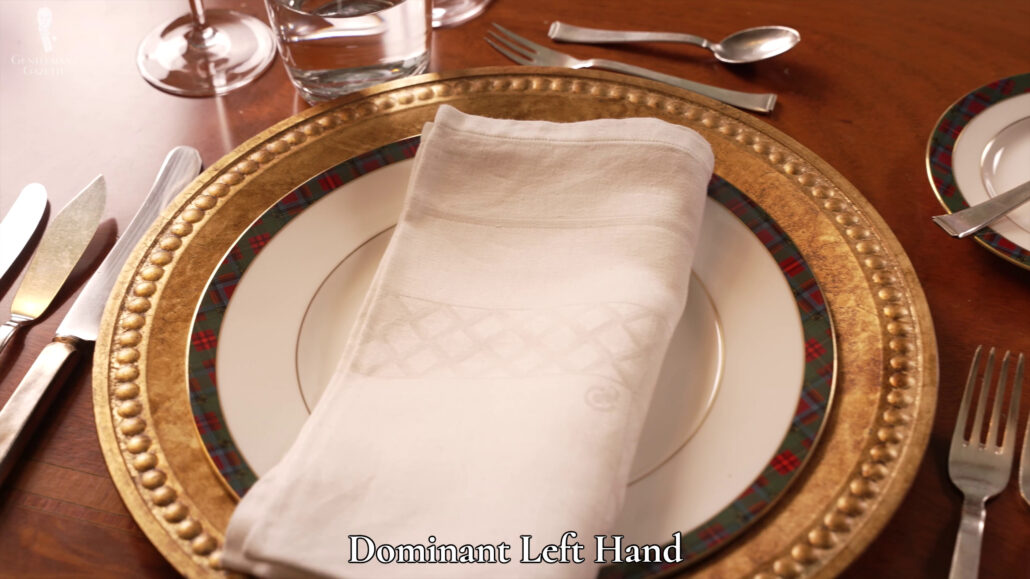
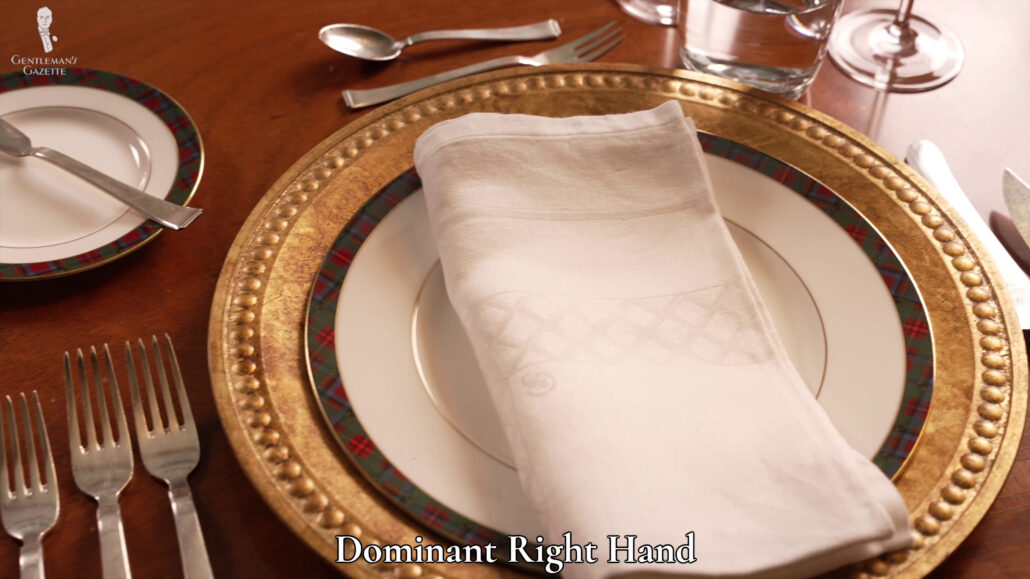
By the way, if you know one of your guests at a dinner party is left-handed, you can switch sides of the knife and fork, so you make it easier for them to eat, but something that won’t go unnoticed by your guest. No, leave the glasses and everything else where it is, but that little thing will probably make their day.
American Style Resting
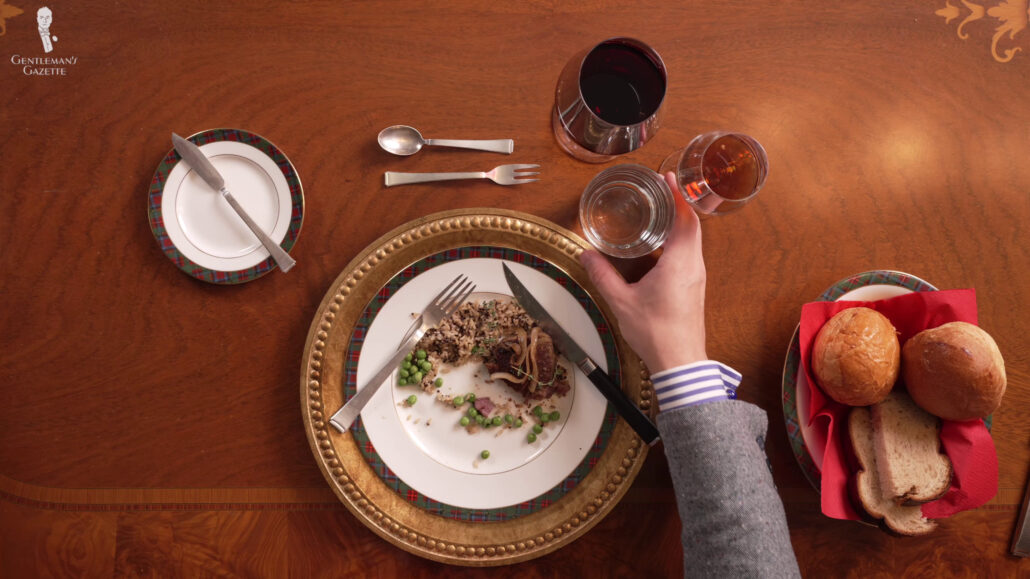
So, with the American Style, if you’re not actively eating, maybe you’re speaking, maybe you’re attending the restroom, or maybe you’re just pausing, but you’re not done yet with your food, place the knife diagonally at the top of your plate, leave it on the plate with the blade facing inwards towards you. Your fork is more on the left of your plate with the tines facing up.
Trained staff at a restaurant should recognize that you’re not done eating yet, and they should leave the plate where it is.
Continental Style Resting
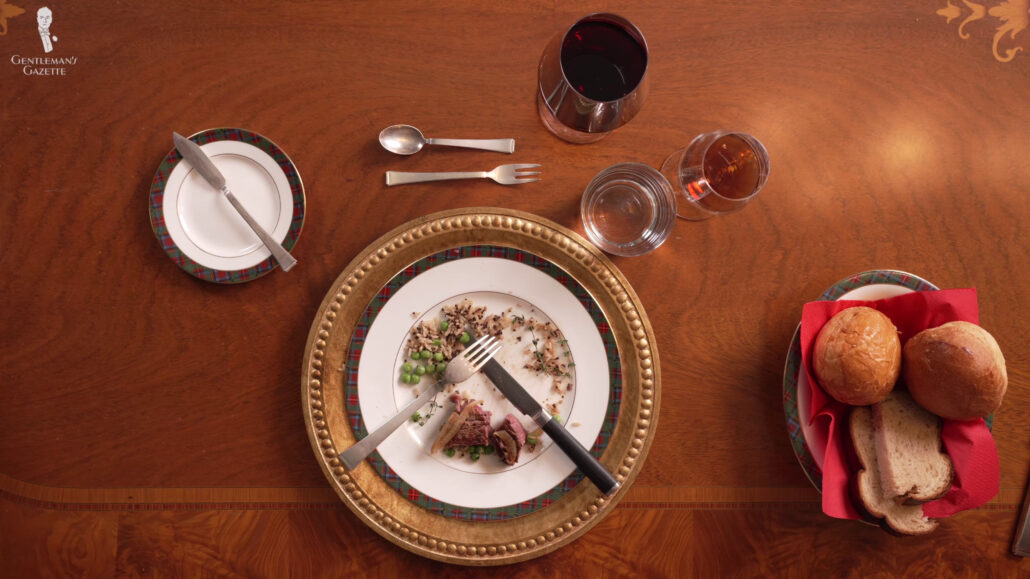
Continental Style, there are two ways to communicate that you’re not done yet. Your knife will be faced blate towards the center at around the four o’clock position, your fork will be placed tines down at around the eight o’clock position, and you create an inverted V.
Another Cardinal Style pausing option is to switch up that inverted V. Now, the knife goes on top of the fork, which has the tines facing up and the blade facing inwards. Either of those three methods should indicate to the host or the server at a buffet that you’re still eating and that you’re not done yet.
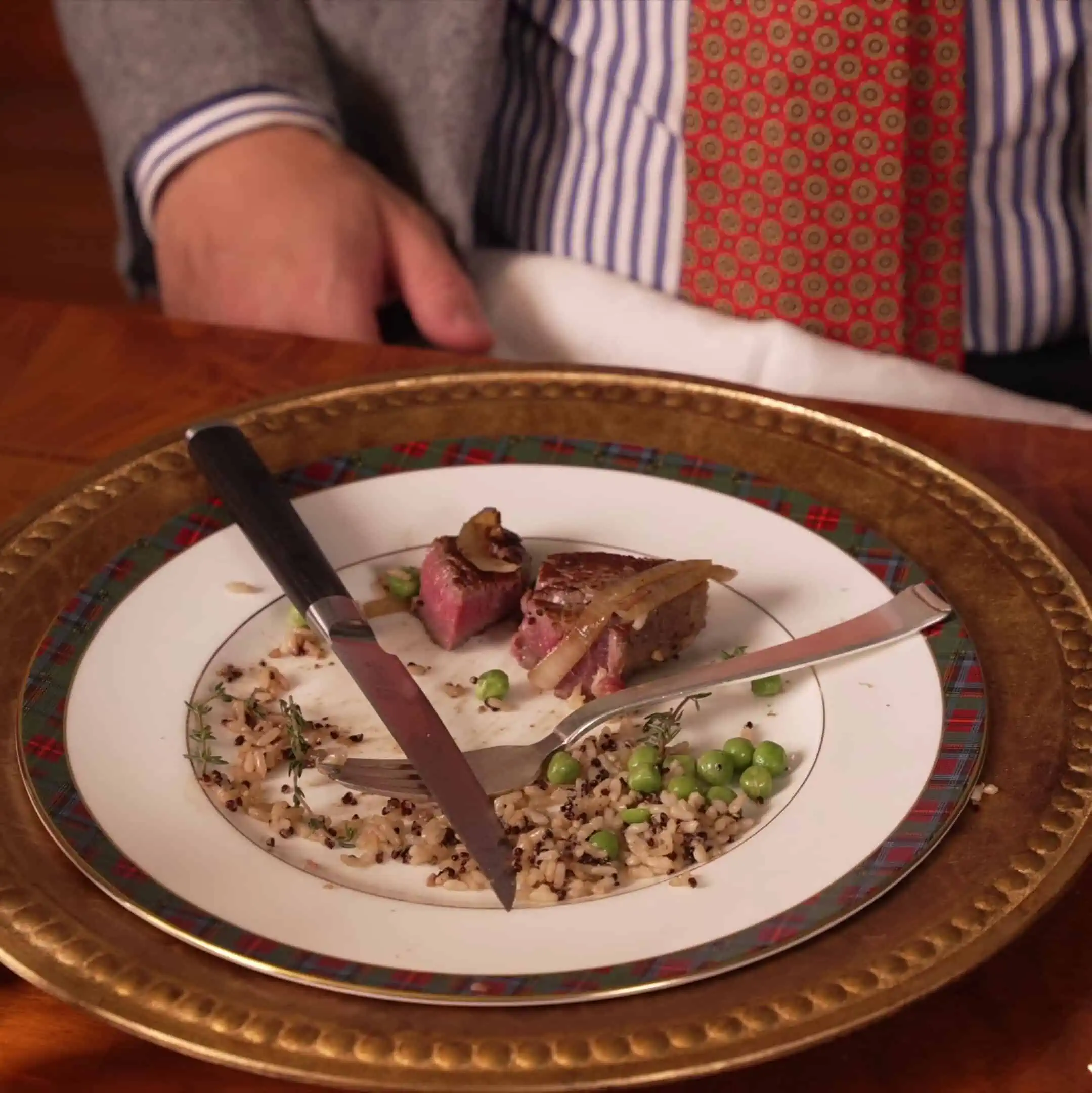
That being said, today, table manners are not something that is universally adhered to. So, your staff may not have the proper training, and they may not recognize that this is what you’re trying to communicate.
Again, it’s important for you to understand what surroundings you’re in. At a high-end hotel, they will certainly take that clue. At a low-brow establishment, maybe not.
American Style Finished
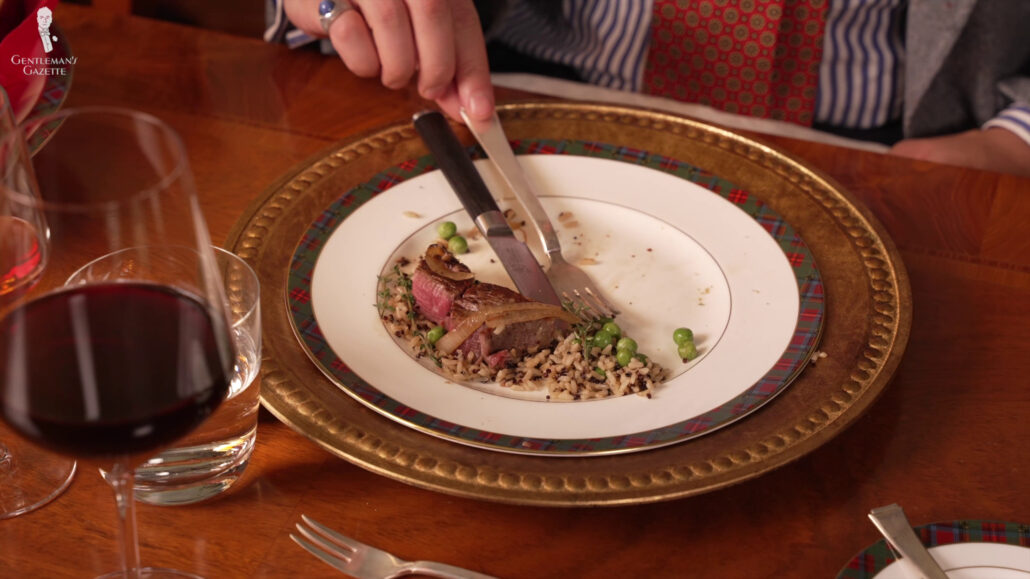
Now, if you’re done eating, American Style, you take your fork and your knife in a 4:20 o’clock position to indicate that you’re done. The fork is on the left, tines facing up; the blade faces towards the fork.
Continental Style Finished
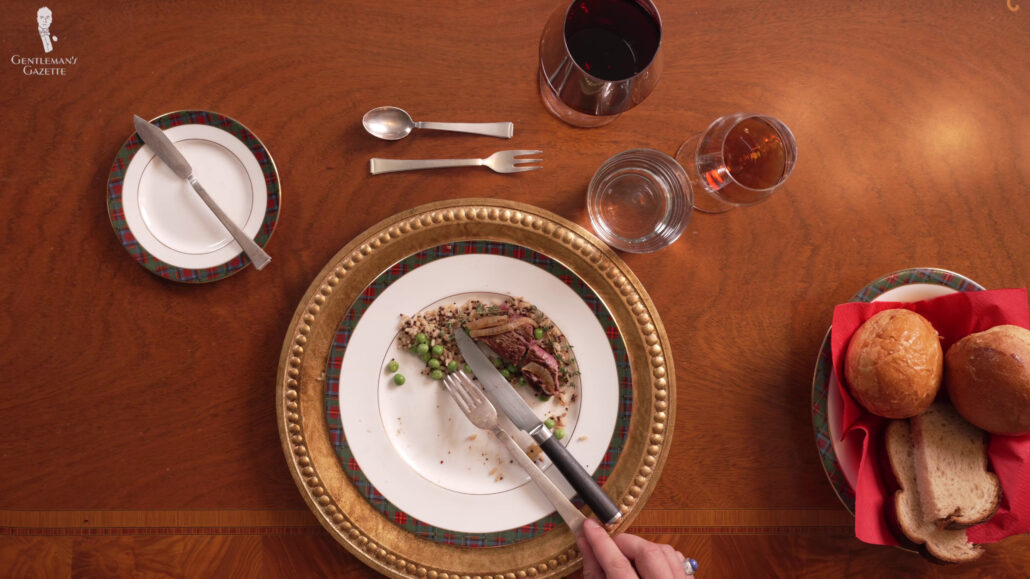
Continental Style, it’s very similar. The only difference is that sometimes the fork tines are facing downwards. They can also point upwards, and the position might be anywhere between 4:20 and 5:25.
It’s important that the handles are just at the edge or hanging slightly over the plate. Don’t shove them all the way onto the plate. You may occasionally see other, clearly intentional ways to arrange silverware in order to communicate a certain message.
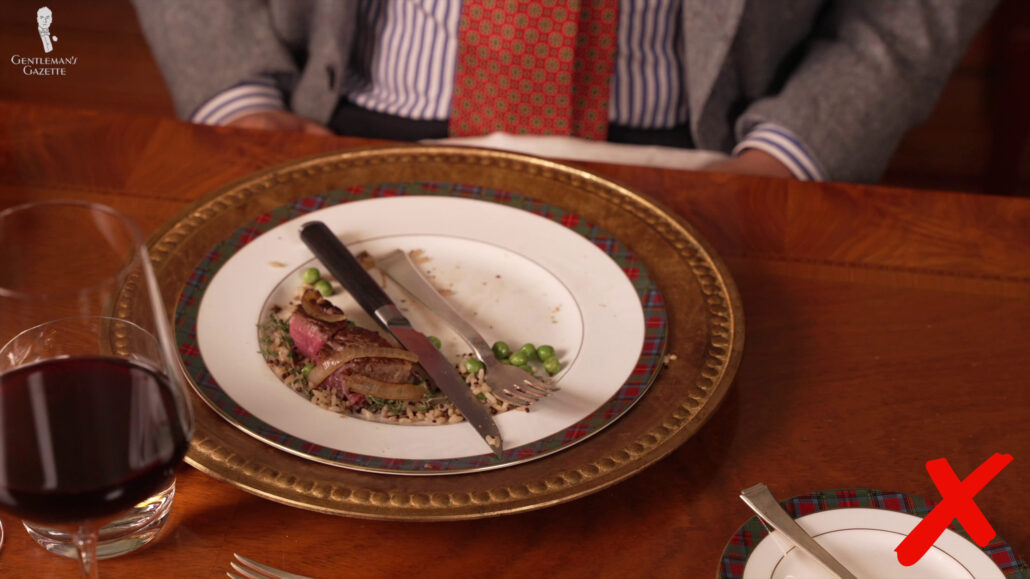
For example, Some people argue that putting your blade through the tines and leaving it in an inverted V communicates the service was bad. Frankly, it’s a very passive-aggressive way to communicate and most people won’t get it anyways.
Or some people think having an X on your plate indicates that you did not like the food. How to behave if you don’t like the food at a dinner party or in a restaurant is covered in our table manners and restaurant etiquette guides.
Restaurant Etiquette: How to Dine Out Like a Gentleman
Why Are There Two Styles?
So, why are there really different styles to begin with? Well, the Continental Style is older. The use of fork and knife to eat became standardized in the Western World in the 17th century.

Ironically, the American Style was developed in France during the 18th century. At the time, it was thought it appeared more elegantly when one hand would rest while the other would do the eating. The cultural exchange between France and the US brought the style over to the US.
However, by the middle of the 19th century, this style had mostly been abandoned in France. On the flip side, it flourished in the US.
Cultural Differences in Fork and Knife Usage
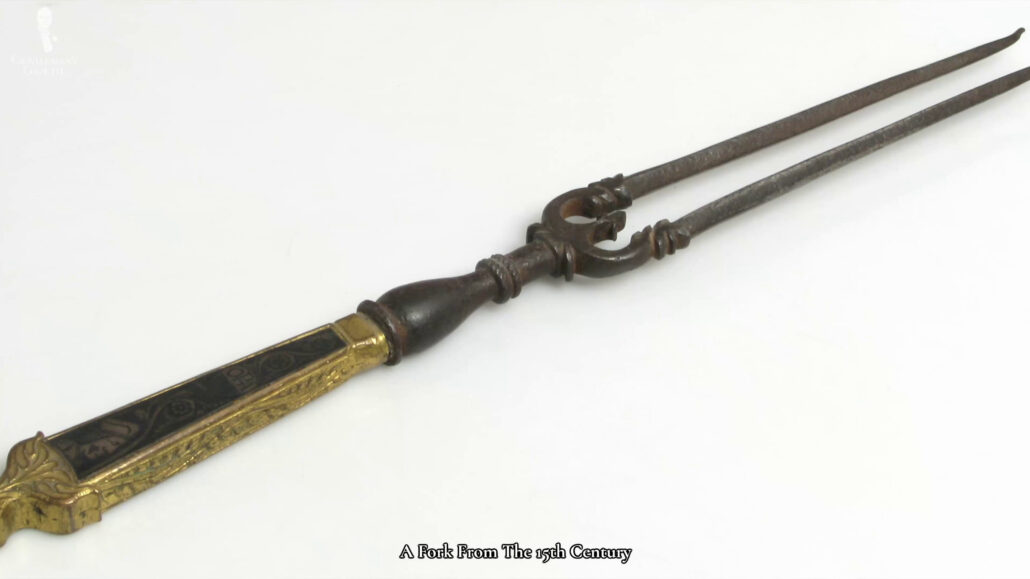
Obviously, many cultures favor the use of hands over forks and knives, and that’s fine, too. And also, keep in mind that, once upon a time, people ate with their hands in Europe, too. In fact, the Byzantine Princess Maria Argyra used a fork in the 11th century. Back then, she was mocked for her decadent and pretentious behavior.
As her critics put it, “She did not deign to touch her food with her hands as normal people do, but instead ordered her slaves to cut it into little pieces, which she speared on a golden two-pronged fork.”
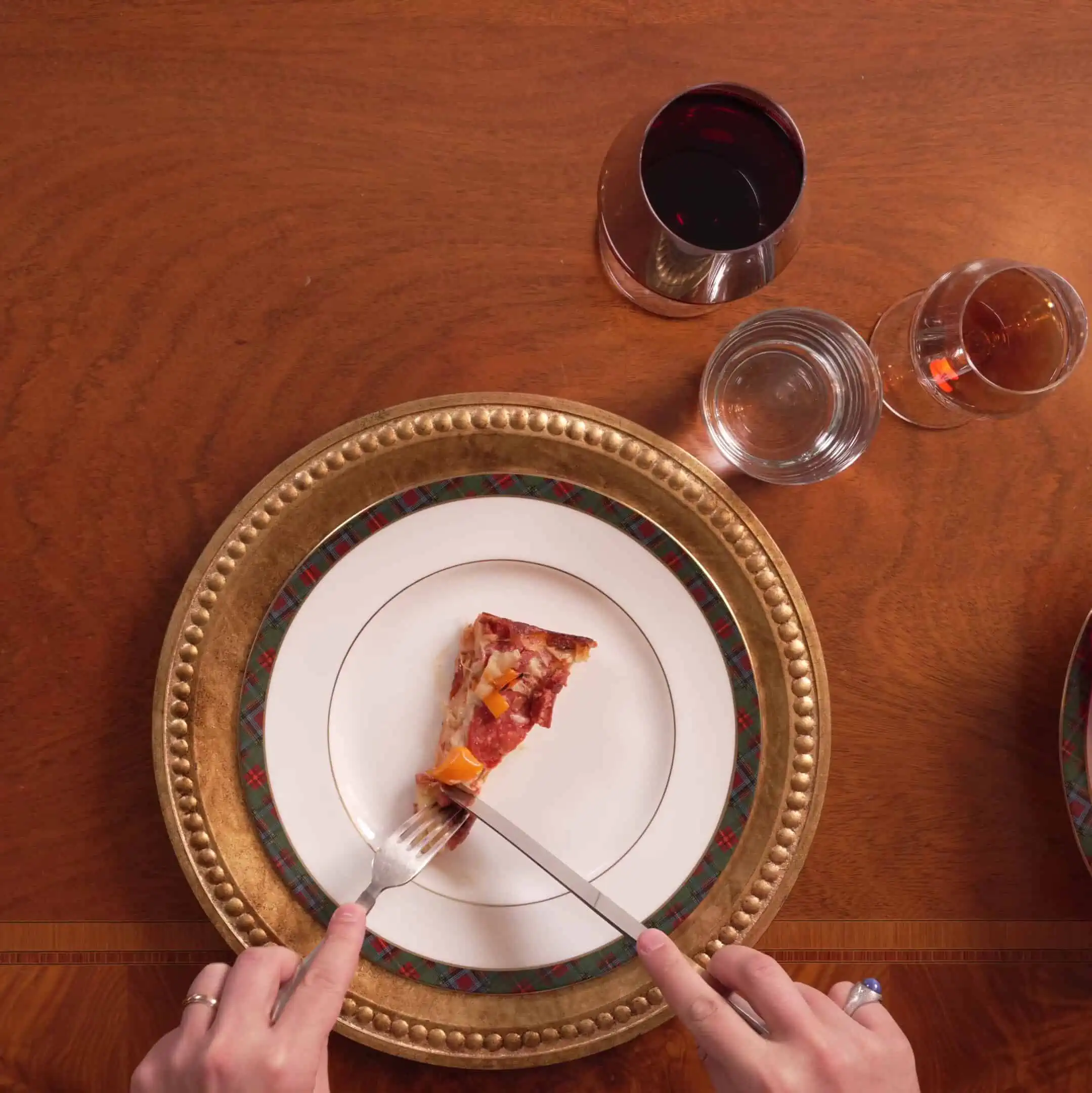
Also, keep in mind that etiquette can vary, not just based on the establishment you’re in, but also based on the type of food you eat. For example, in Germany or Italy, it is normal to eat your pizza with a fork and knife; however, doing so in New York City is apparently headline-worthy.
While, allegedly, the late Queen Elizabeth II ate her banana with a fork and knife. First, you cut off one end, then the other. You hold the banana, slice open the peel, and then gently cut individual pieces out that you then put into your mouth.

Personally, I think context matters the most. For example, if I’m at an interview and I only have the choice between a burger and a club sandwich. I’d prefer to eat them with a fork and knife, so I can take notes. My hands are not sticky because the ketchup is leaking all over it, and it leaves a professional impression on my interview partner.
Frankly, when I go to a burger joint, I regularly use fork and knife. My wife always laughs at me because she likes to eat the American way, with her fingers. Sometimes in North America, if you go to a restaurant, all they give you is a fork, and if you want a knife, you have to ask for it, and even then, they may not have it.
In the US, it’s much more common for people to just cut their food with their fork when that is what they have. I’ve even seen people try to go at it for chicken or pizza, for example. Personally, I don’t think it’s a good idea. If you apply that much pressure with a dull instrument, your food may go flying all over the table or, even worse, onto someone else’s lap.
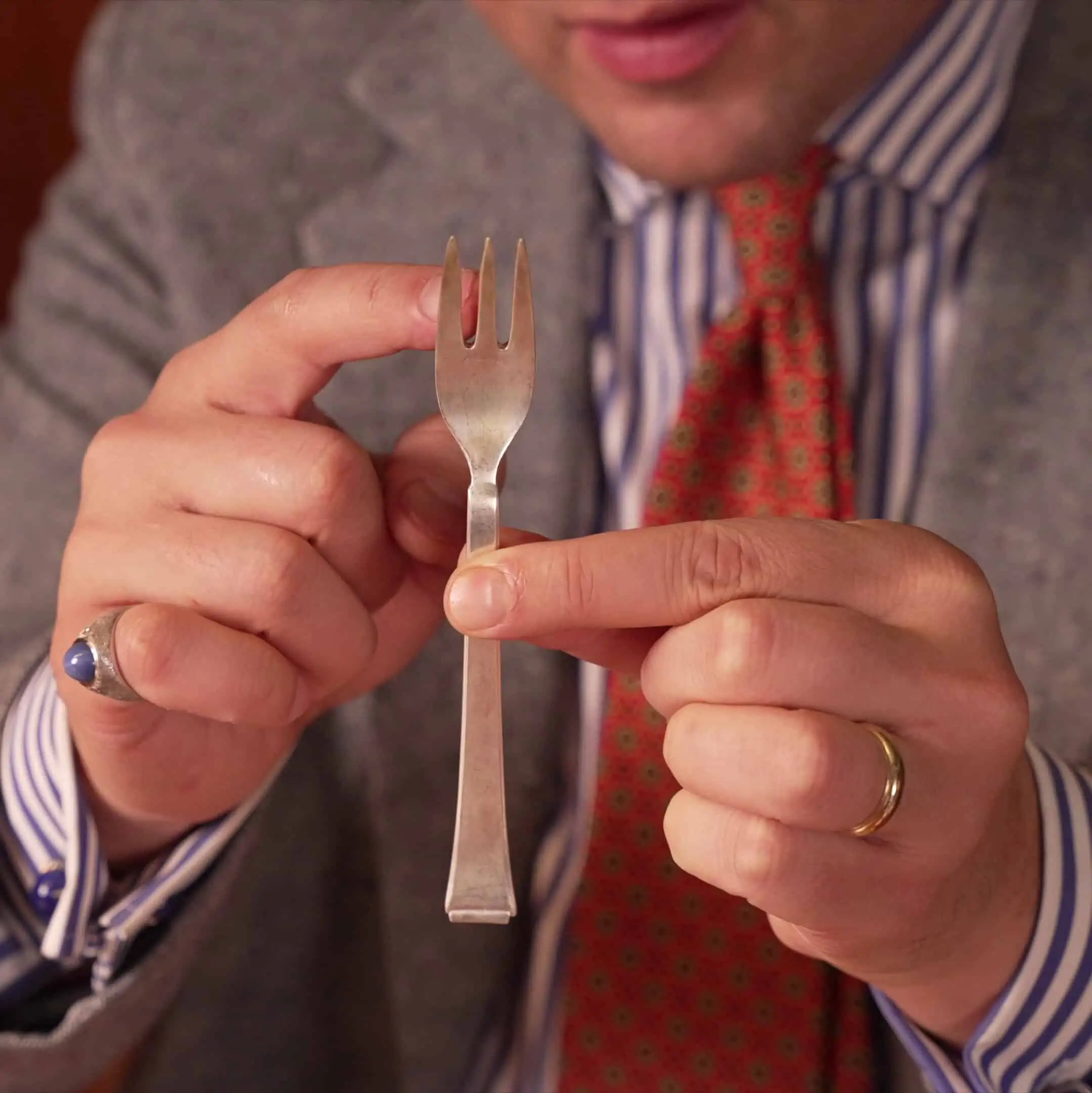
While that may be commonplace in the US, it is definitely considered impolite and improper in Europe; except, of course, for things like pastry forks, which have a special design that helps you to cut, let’s say, your cake crust more securely when you don’t have a knife. More about that later.
When and Which Fork and Knife to Use
When you’re about to enjoy a multi-course meal, chances are you will encounter a multitude of forks, knives, and spoons at your table. The number of courses as well as the formality of the meal, often indicate and dictate how many pieces of silverware you’ll find at your place setting. In most places, will have a single fork and a single knife.
Salad Fork
Traditionally, the knife is placed on the right, with the blade facing toward the plate, and the fork is on the left. Now, if you have more courses, you may find an additional salad fork and an additional salad knife. Maybe specialty utensils, such as a fish knife or a shellfish fork.
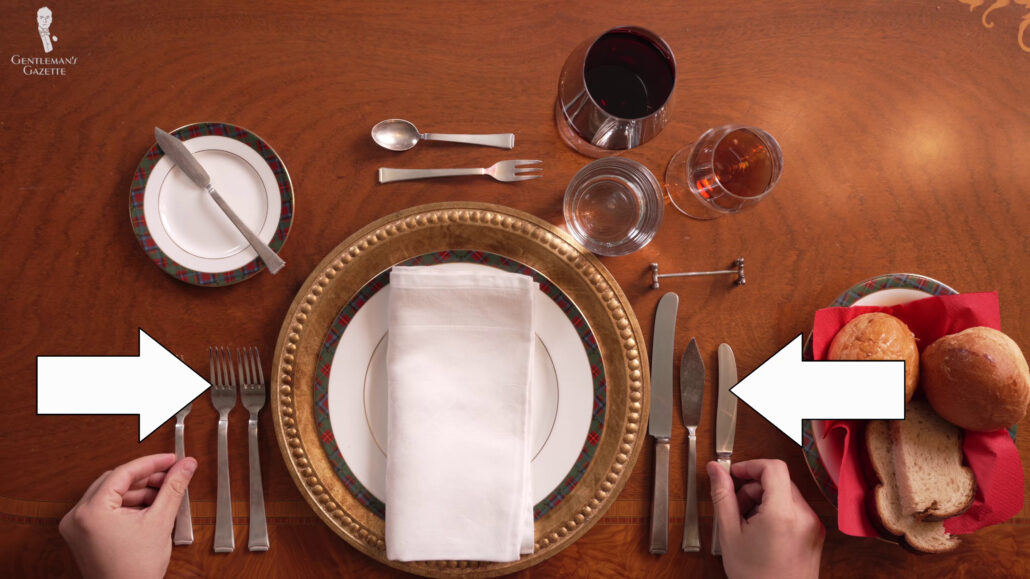
As we mentioned in our table etiquette, it’s typically very simple. Work your way from the outside in, and you won’t commit a faux pas. When you’re done, leave the utensils on the plate and they will be removed.
Now, in the US, many times, even at restaurants, you’ll see the constellation where you have two forks and one knife. The fork on the very outside is meant as a salad fork, and you can still use your knife to eat with it. But, in case you use your knife for the first course, it is often expected that you keep your knife.
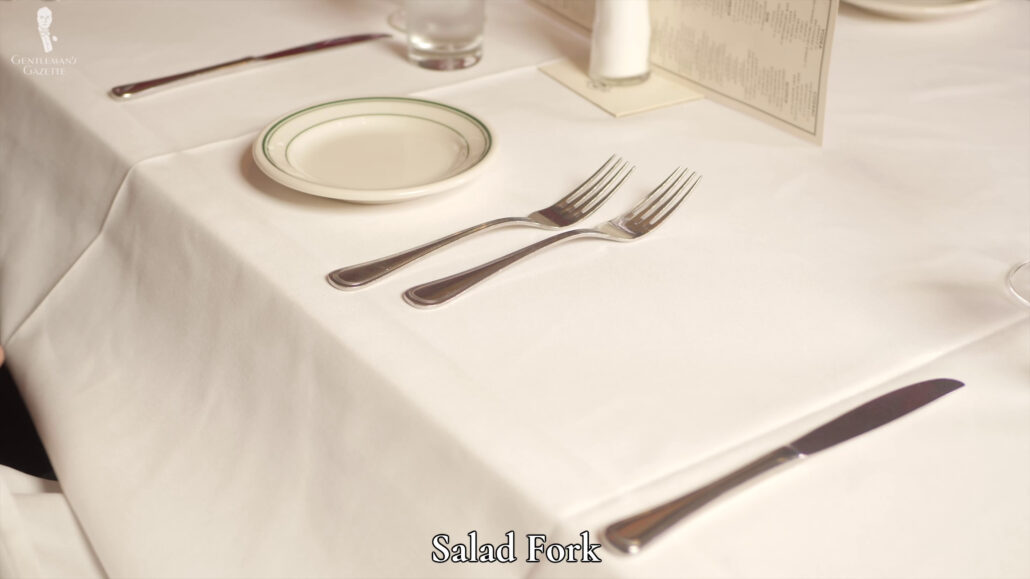
Personally, having grown up in Europe, I always have my utensils on it and have them remove them and bring me a new knife. I don’t think that’s too much to ask, especially in a restaurant setting. If I’m at someone’s home, they may not have enough silverware, so I go along with whatever they’ve set out.
Steak Knife
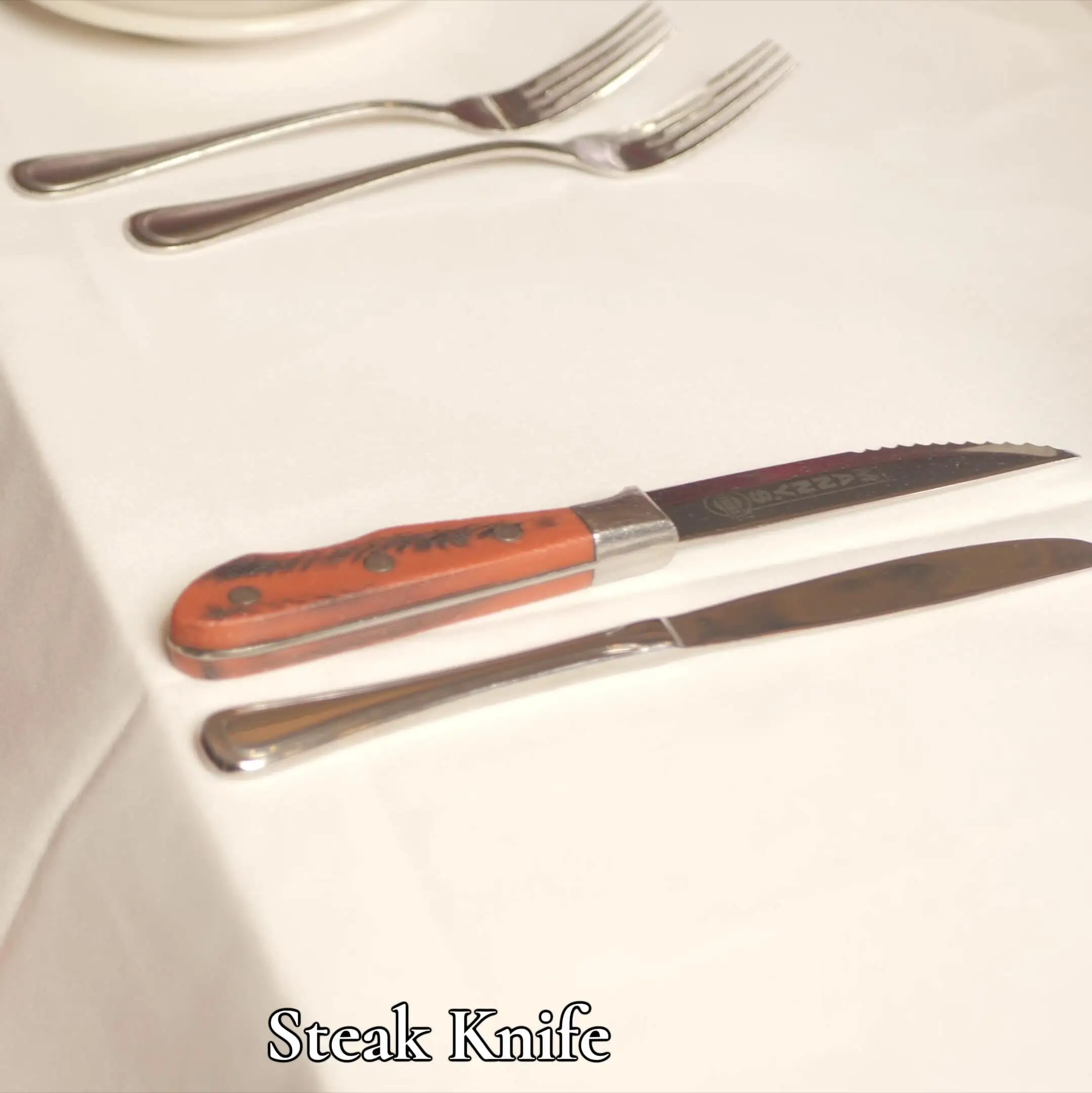
For example, a steak knife. If you order a steak in the US, you typically get a steak knife. Sometimes, they also so give you one if you order a pork chop or maybe even a chicken. If they serve it to you, it’s probably a wise idea to use them because, typically, they have a sharper blade, and it will make your life easier.
That being said, sometimes you will get a tough sausage, and they just give you a dull knife, and they give you a filet mignon and a steak knife, even though you can totally cut it with a dull knife, too. In that case, use what works for you.
Bread Plate
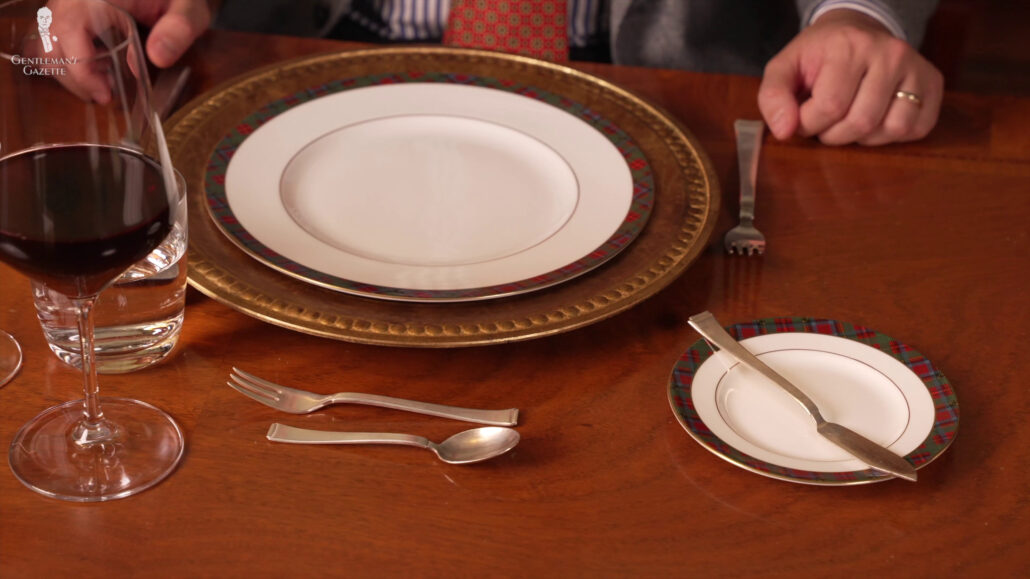
Another important aspect of knife etiquette is the butter knife on your bread plate. Typically, in a nicer establishment, you will have a bread plate that is located to the left top of your plate, and it will have a butter knife on it.
Most of the time, there will be a bread basket or something comparable. They may have some olive oil, or they may have a little butter container.
If that communal butter container or butter plate has a butter knife, what you do is: you take that knife, take some butter, place it on your plate, then you take a piece of bread, you take your knife, and butter that individual piece of bread, and then put it in your mouth.
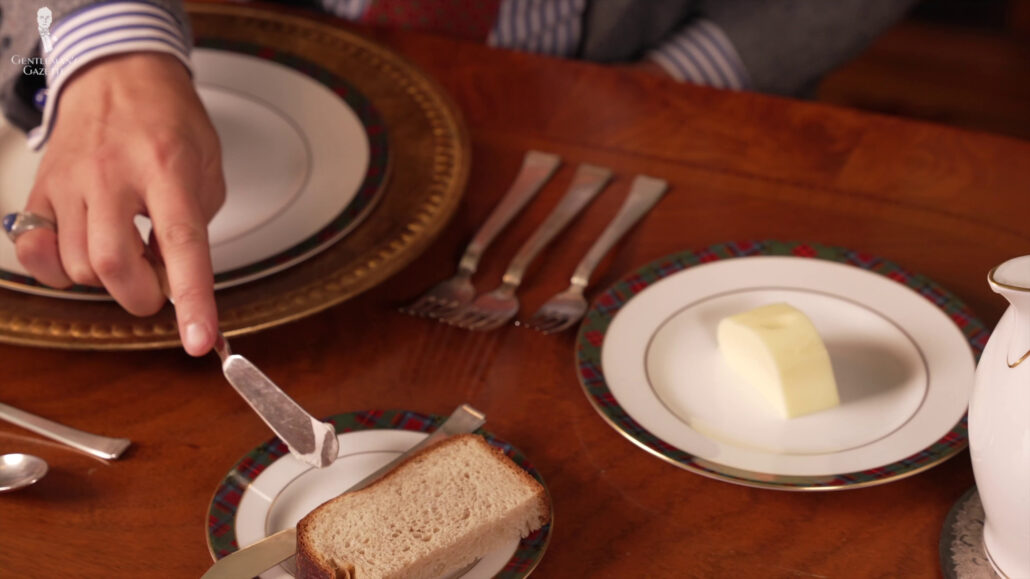
In Europe, that is a very common practice. The only time where you can actually butter your entire bread and bite into it is at breakfast, never at lunch or at dinner.
Let’s say, the communal butter plate does not have a butter knife. In that case, you use your unused butter knife from your plate only once to get the right amount of butter for what you think you will eat onto your plate. You will then proceed again to break up your bread and butter the pieces you put into your mouth.
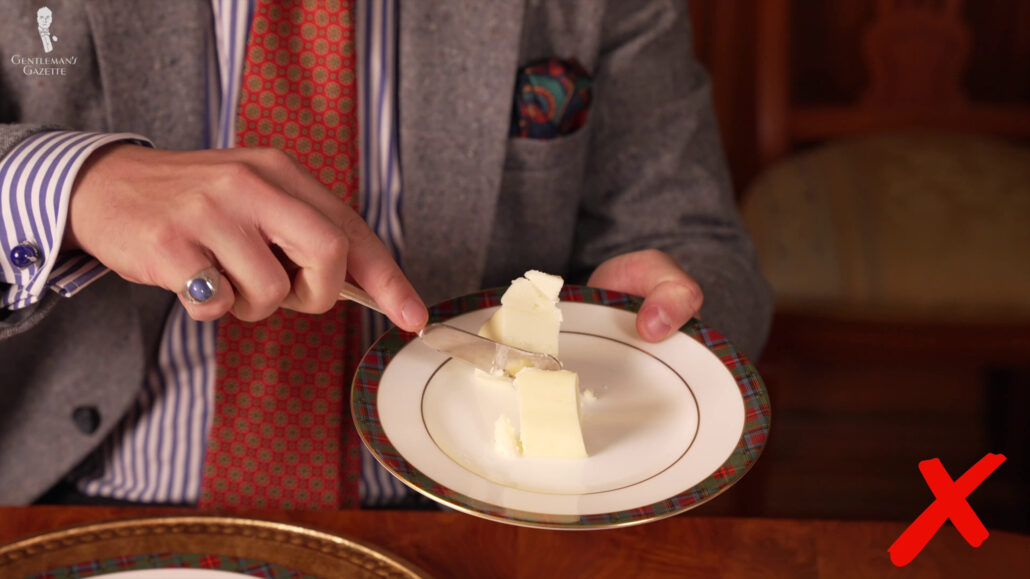
Do not use that same knife again to go to the communal plate and get butter off of that. Also, be mindful of the other people at your table. If there are eight people, and you take half the amount of butter, chances are someone will not get enough. Of course, you can always ask for more, but just be mindful of your surroundings.
In Germany and Austria, potatoes are traditionally not cut with a knife, but broken with a fork. Some people argue that these uneven surfaces make it easier for the sauce to cling to the food, and therefore, it tastes better. Others also argue that if you actually use a knife to cut your potato, you indicate that the chef or the cook didn’t sufficiently cook the potatoes. Now, that’s not something you want to communicate probably.
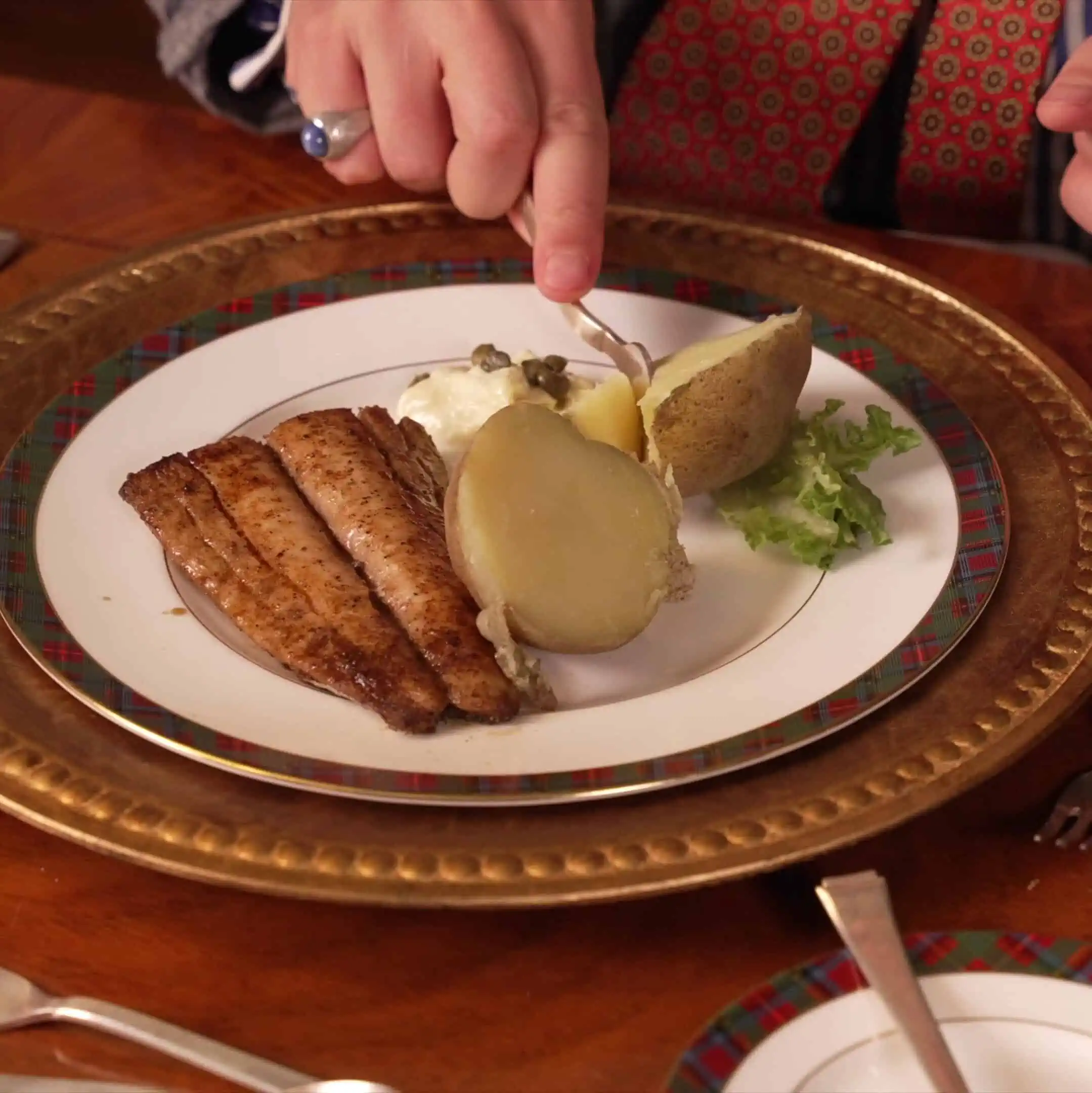
Also, historically, old steel blades may have left an off flavor on the potato when you cut it. But, in this day and age, where stainless steel blades are the norm, you don’t really have to worry about it anymore, and you can safely cut your potatoes with a knife in urban Austria without committing a faux pas. That being said, it’s still okay to do it the historically accurate or traditional way.
Fish Cutlery
The off flavors neatly transition us to fish cutlery. Traditionally, in Europe, there was a fish knife, which had a different shape, and it was made out of a different material without the blade, so again, you wouldn’t get these off flavors.
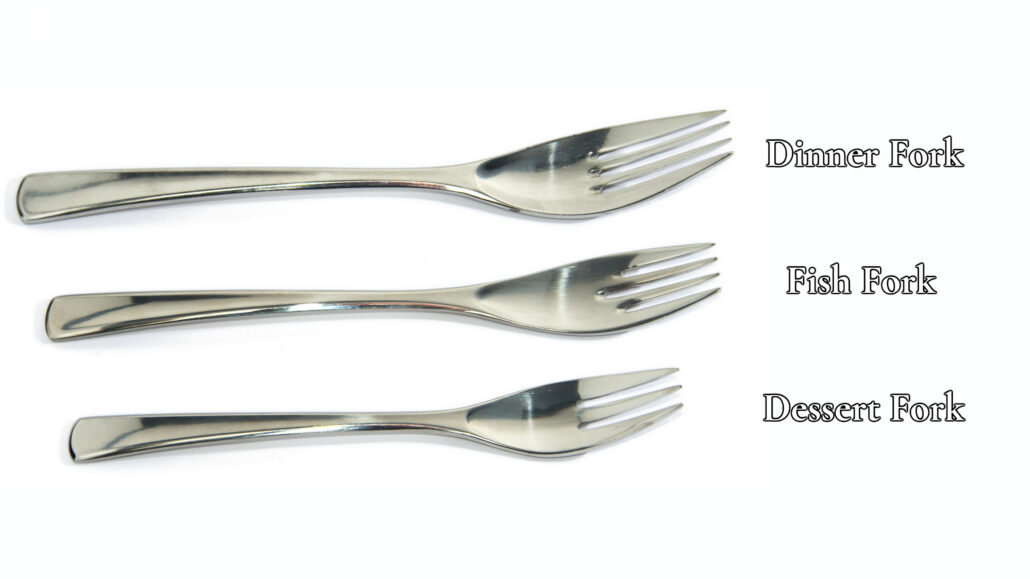
In the US, I’ve never seen fish cutlery at restaurants. It’s just not something that people do, and, again, in this day and age, it is not necessary.
In Europe, while they may not serve you a fish knife, they may just serve you a second fork that looks like the other ones. You may also find a special fork that looks visibly different. So, in that case, it’s just easier for you to identify which fork is the fish fork, so you don’t accidentally grab the wrong one.
Pastry Fork
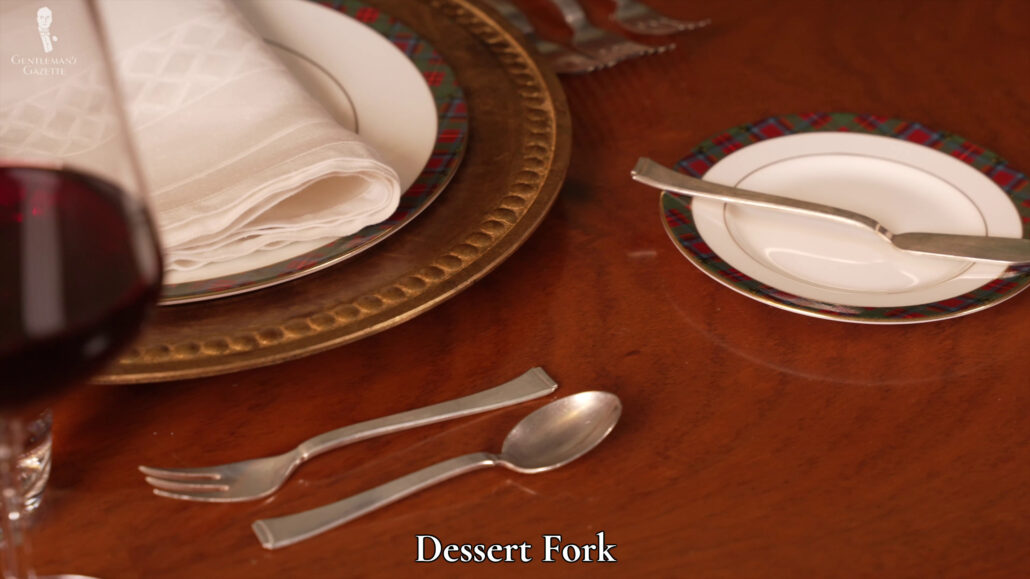
Before going too much into the weeds, let’s just talk about the pastry fork or the dessert fork. In Europe, typically, you will find it placed horizontally on the top of your plate. Often, there’s also a spoon placed in the opposite way.
What would happen in Europe, at the restaurant, with your dessert cutlery is that the fork would be pulled down in the spot where the other forks used to be before, and the spoon would be put in a place where the knives used to be. Of course, in a restaurant, they don’t know if you’re gonna order ice cream for dessert or something that requires a spoon, or maybe something like a cake that is better with a fork.
Cake forks in Europe are distinct. They typically have three prongs with the one prong on the left being quite a bit wider. And if you take a closer look at it, you can see that it is narrowing down similarly to a blade. No, it’s not as sharp as a blade, but it certainly makes it easier to cut soft things like cake with your fork.
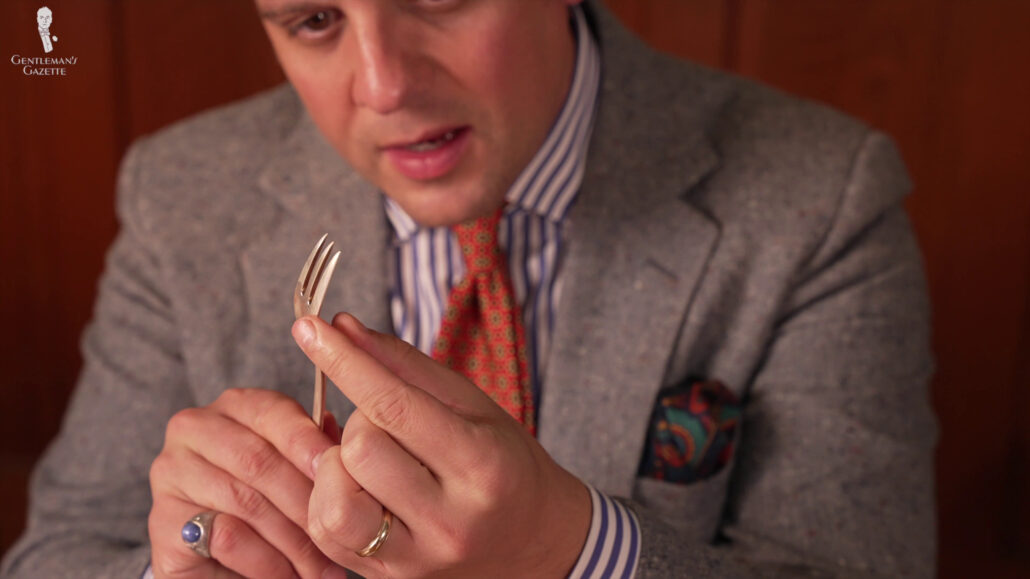
When you eat desserts, you just take your fork, and the same rules apply as mentioned before, and you gently either pierce or slide your fork under it. Always avoid using your fingers to push anything on your fork.
If you have a dinner party at home and you know what you’re going to serve for dessert and you know a spoon is not required, you don’t have to put it there. Likewise, if you know that you’ll only need a spoon for dessert and no fork, you can also skip the fork.
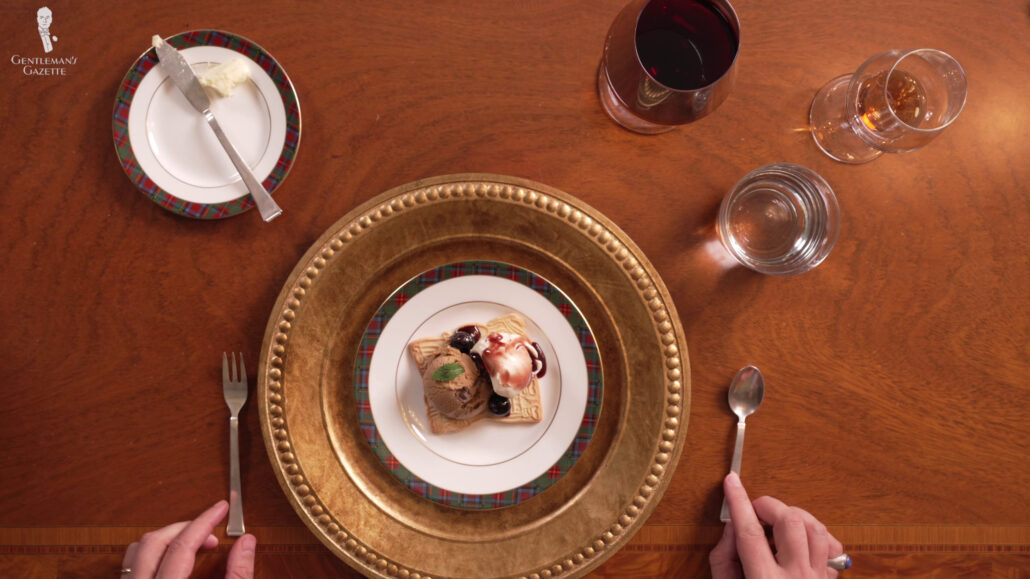
Personally, I always think it looks nice, and the orientation is very simple. You just place the fork first, and you basically imitate the pulling down motion to a place where you want to put a fork, and that gives it your orientation for the fork, and then a spoon just goes the other way.
Fork & Knife Do’s & Don’ts
1. Understand Your Surroundings
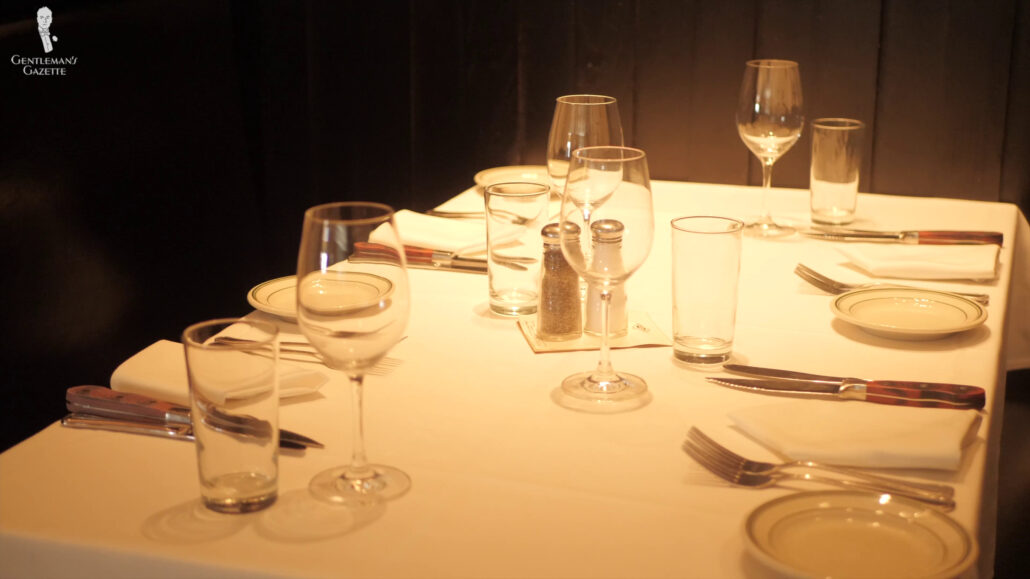
Last but not least, what are some do’s and don’ts of using your fork and knife? The most important one is: do understand your surroundings.
If you’re eating with a Chinese family, and it’s customary to do so with chopsticks and to eat loudly and burp to indicate that the food is good, then go along with that. If you’re at a low-brow burger joint, where everyone is eating their burgers with their hands, by all means, go for it.
You’re at a nice restaurant with a beautifully set table and many pieces of silverware; keep these table manners in mind.
2. Don’t Eat With Your Knife
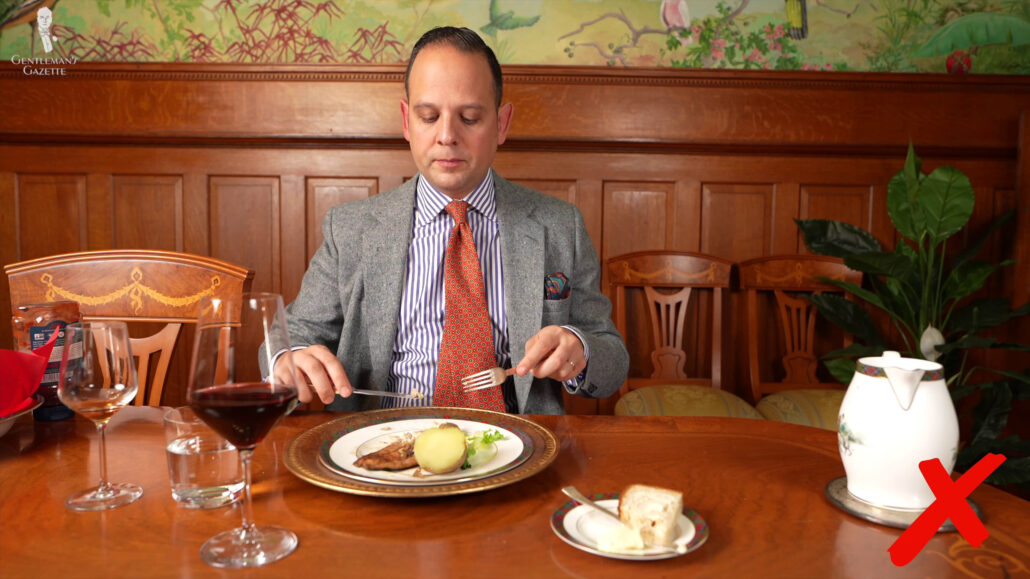
It is sharp, you may cut yourself, it looks bad, and that’s pretty much all I have to say about that.
3. Give People A Chance To Eat
Give people at your table the chance to actually eat with your fork and knife. Now, this one may surprise you a little bit, but it’s really important. Let me tell you why. I’ve definitely been to dinner parties where there are some people who are really chatty, and they talk all dinner, so one person is already done with their meal when the chatty person hasn’t really started yet.
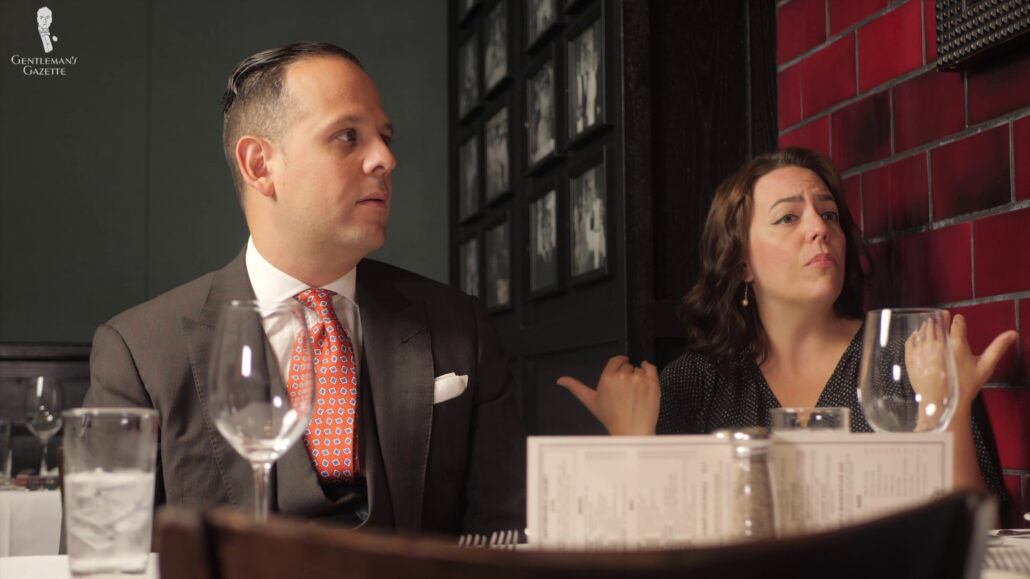
No matter if you’re in a restaurant or in a home setting, it’s always uncomfortable for the chef to cook because nothing is done at the same time, and you don’t want to clear the table if someone is still eating, and it just creates a mess.
So, how to get around that? Basically, you just ask open-ended questions. When you do that, your neighbor or the person you’re speaking to will start talking. During that time, it is your opportunity to take a bite.
When they’re done with their answer, ideally, just like in a ping pong game, they should ask you an open-ended question, so they can take a bite and eat, and so it goes back and forth and back and forth.
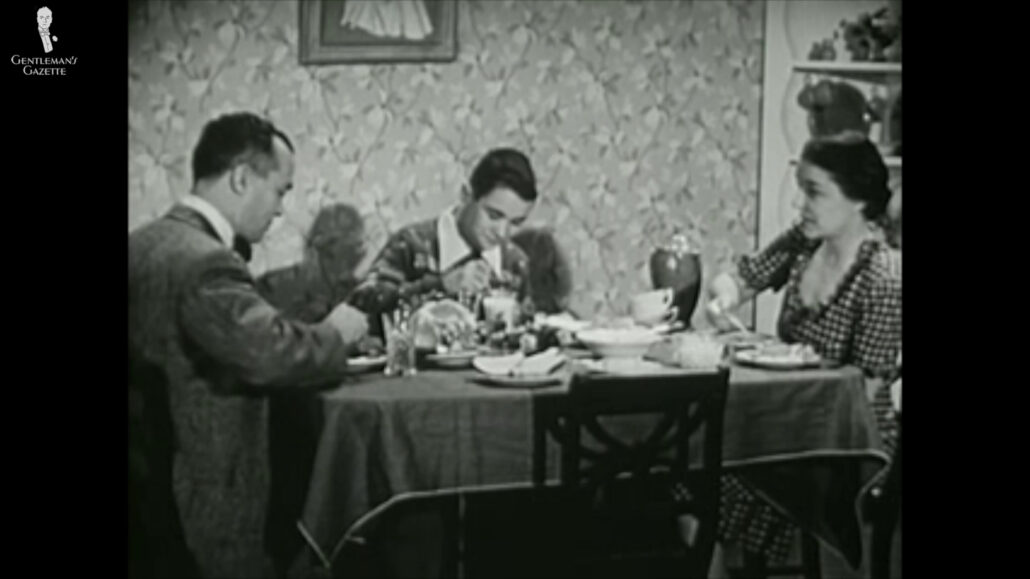
Of course, if the party at your table doesn’t get that and either doesn’t ask you any questions or just asks you yes or no questions, it might be difficult for you to get a bite in. In those situations, it’s okay to have a moment of silence where you take a bite, but it is always really awkward when people are just sitting at the table and eating without having a conversation.
After all, it’s a joy of life to eat together and have a wonderful table conversation.
4. Use Quality Silverware
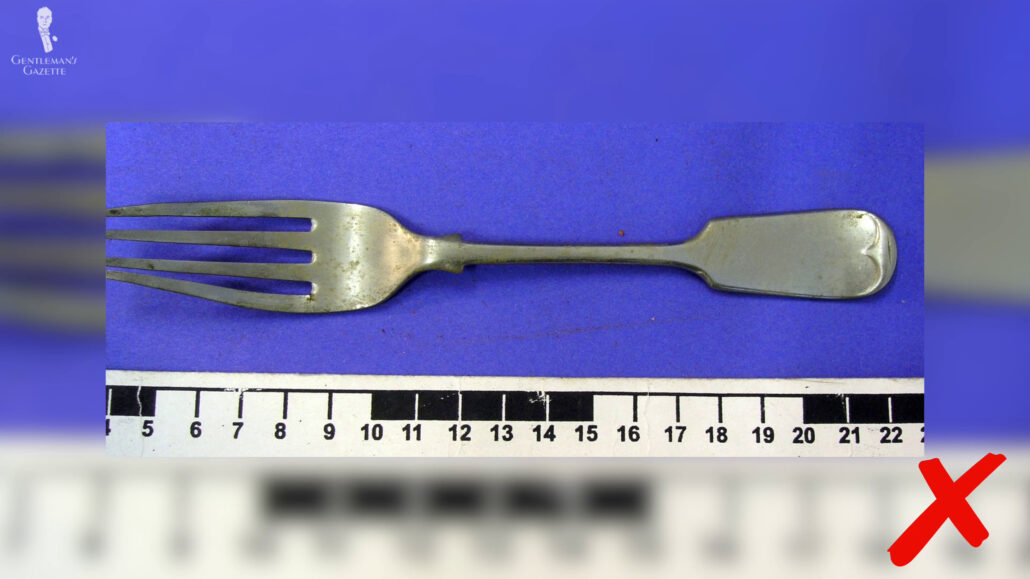
While it is a functional piece on your table, if you have that thin crappy silverware where the tines are all bent, I think eating is just not as joyful. If you care about the way you look and you’re interested in aesthetics, you might find that having a set of silverware that matches your personal style – whether that’s Mid-century Modern or Empire – is quite cool.
5. Don’t Use Plastic Utensils (If You Can Avoid It)
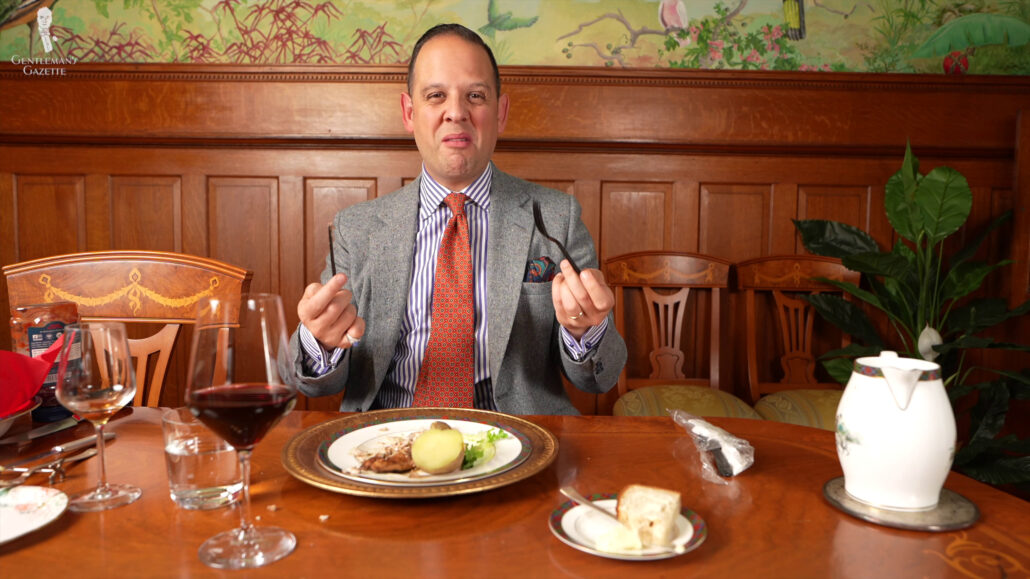
Personally, I hate paper plates and plastic silverware because, typically, the tines are too short, the knives are not sharp, and then if you apply too much pressure, it breaks. And now, you’re just left with something that you can’t cut. It’s flimsy, it’s ugly, it’s bad for the environment. So, do yourself and others a favor and get real silver if you can.
Yes, I do bring proper silverware even to a picnic, but that’s just me, and I hate plastic silverware.
6. Use A Firm Grip
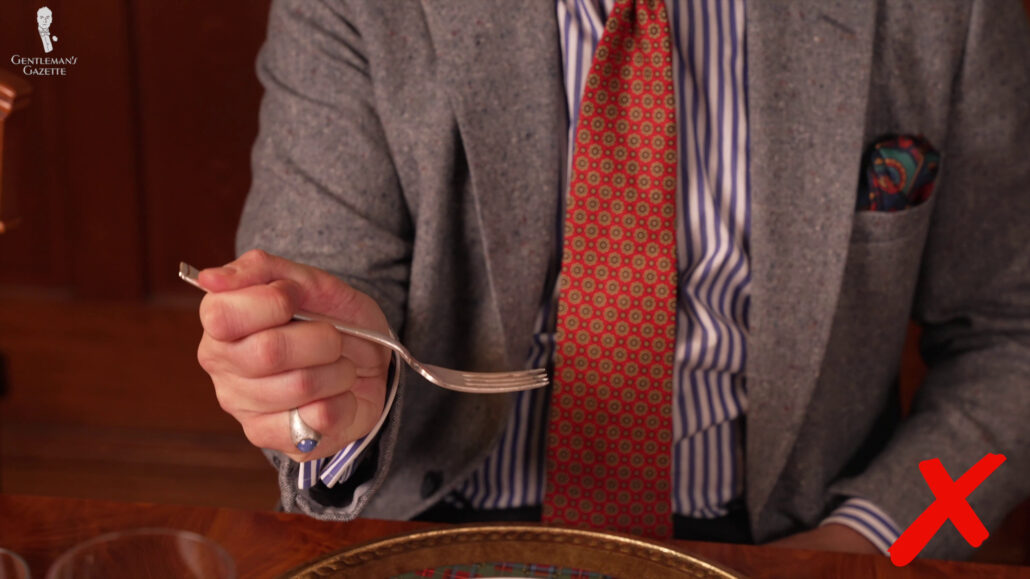
Do have a firm, but not cramped handle grip on your silverware. Otherwise, you will just tense up in your muscles, it won’t feel good after a three-hour dinner, and people can see that you’re not at ease.
7. Hold Your Fork & Knife Properly
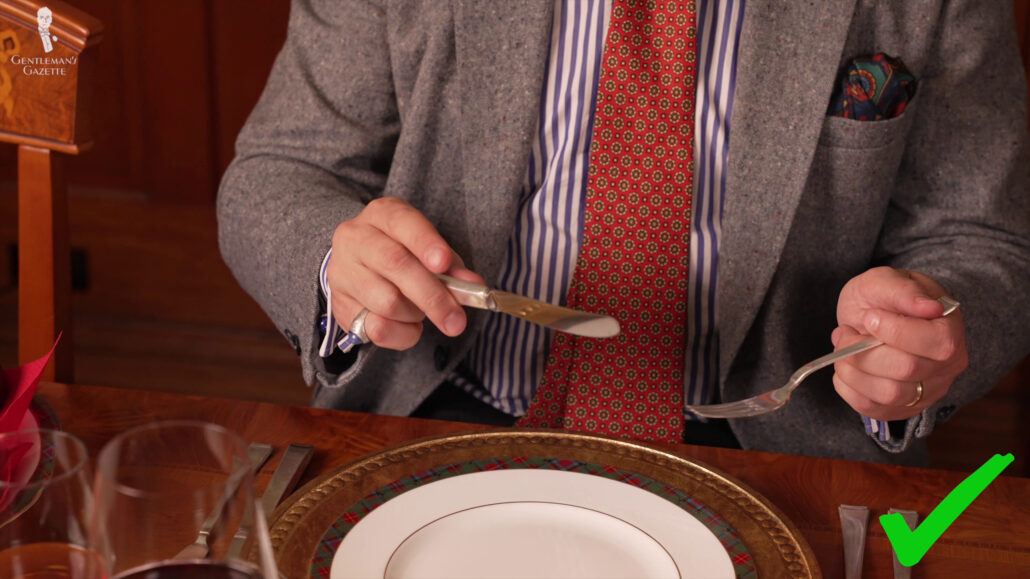
Don’t hold silverware in weird, awkward ways, such as with the fingers all around the handle or like a pen. It makes you look like a four-year-old or, even worse, like a peasant.
8. Take Small To Moderate Bites
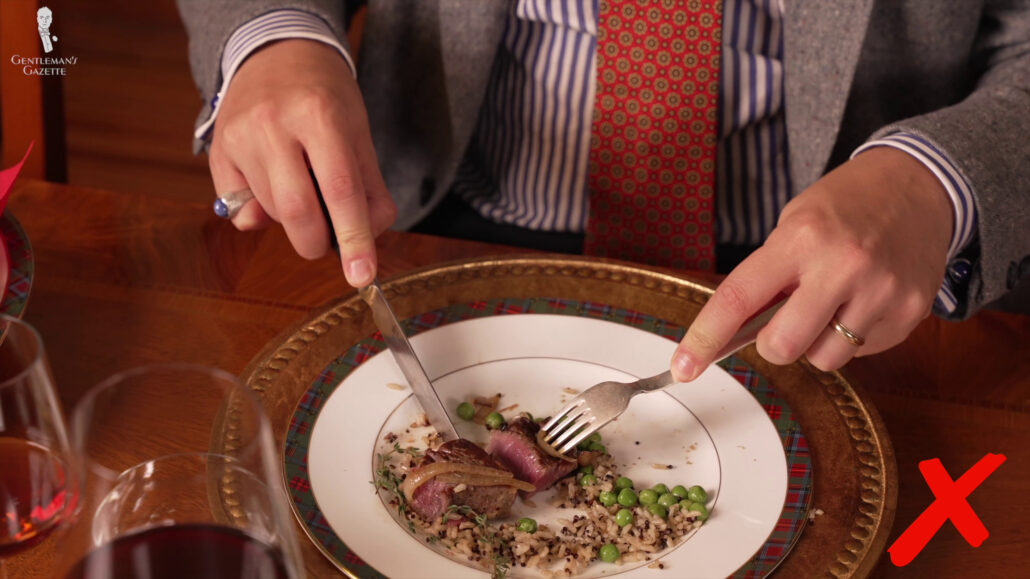
Don’t overload things and stuff your mouth full.
9. Don’t Use Your Fork Like A Shovel
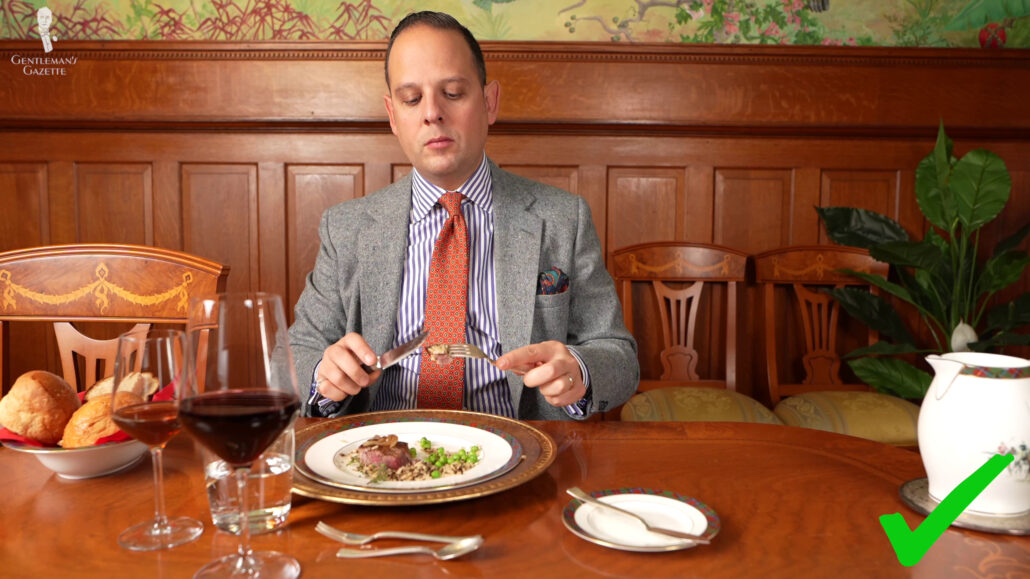
Don’t use your fork like a shovel to just get as much food into you as quickly as possible. Sit upright, take a bite, enjoy it, and your body will take some time to register that you’re full. And you’re much more likely to overeat if you super fast shovel stuff into your mouth.
Now, my wife will laugh about that one because I’m certainly someone who can eat really fast, and that’s probably one of my biggest struggles: to pace myself. But, I find it is much easier when in good company because I can ask a question, I get asked questions, I can talk, and so this all happens naturally.
So, if you’re struggling with it, try to incorporate more table conversations, and maybe it helps you, too.
10. Bring Your Fork To Your Mouth
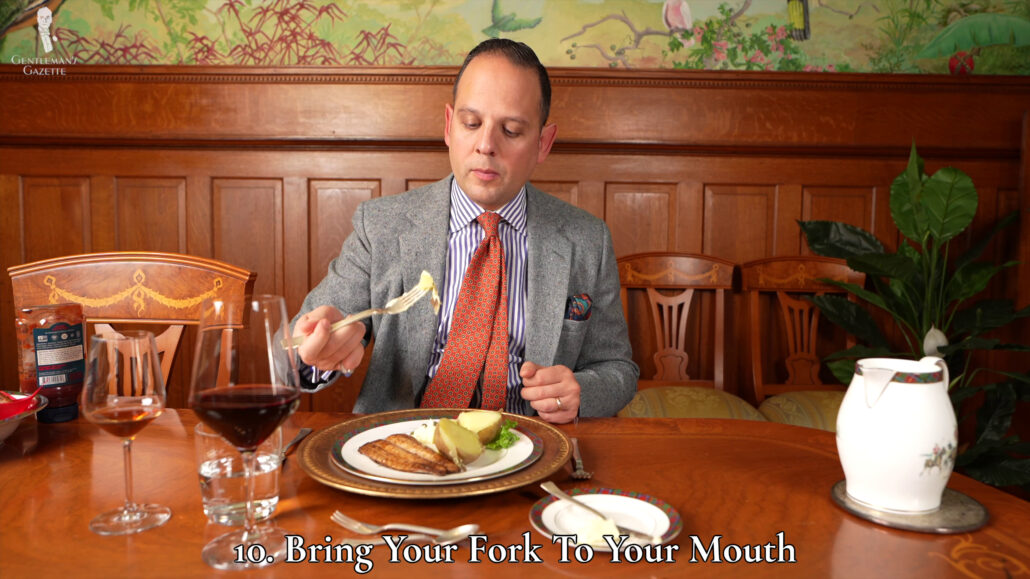
As mentioned before, don’t move your mouth down to the food. Bring your fork to your mouth.
11. No Elbows Or Arms On The Table
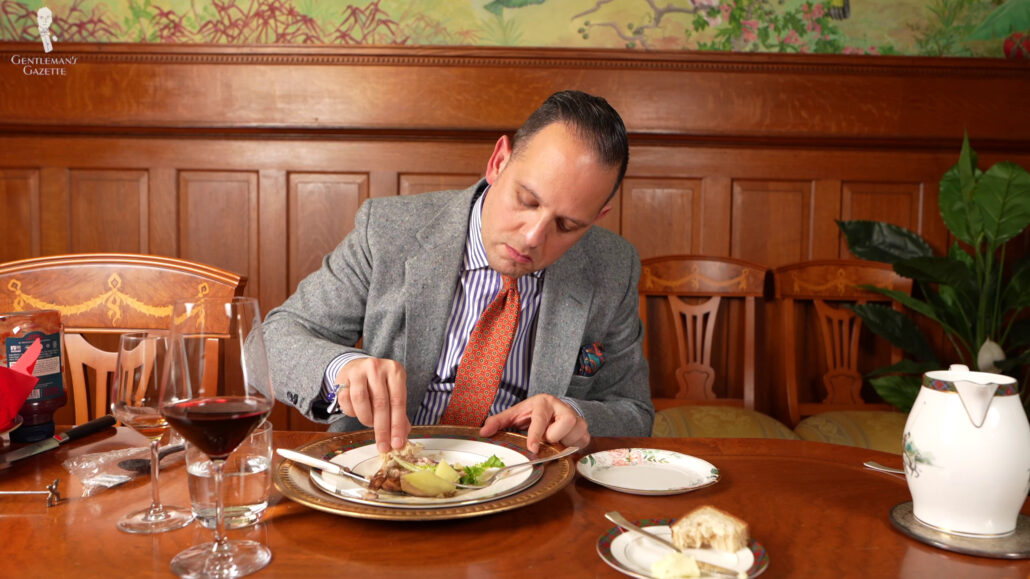
Don’t rest your elbows or your arms on a table in an unsightly manner. If you quickly have to touch your forearms at a table that is okay, but it should not be in a slouchy, inelegant way.
12. Don’t Slice Your Food All At Once
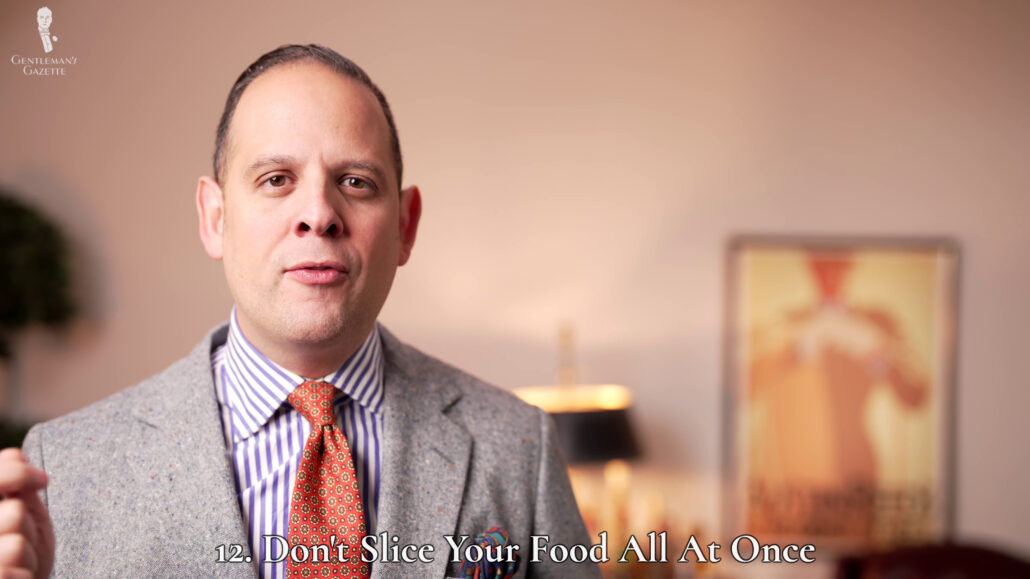
Don’t slice up all your meat or food up front, and then just put your knife aside and eat with your fork. First of all, the food cools down much faster that way; and secondly, this is something you do for two-year-old kids, not for grown people.
13. Use The Right Utensils For The Job
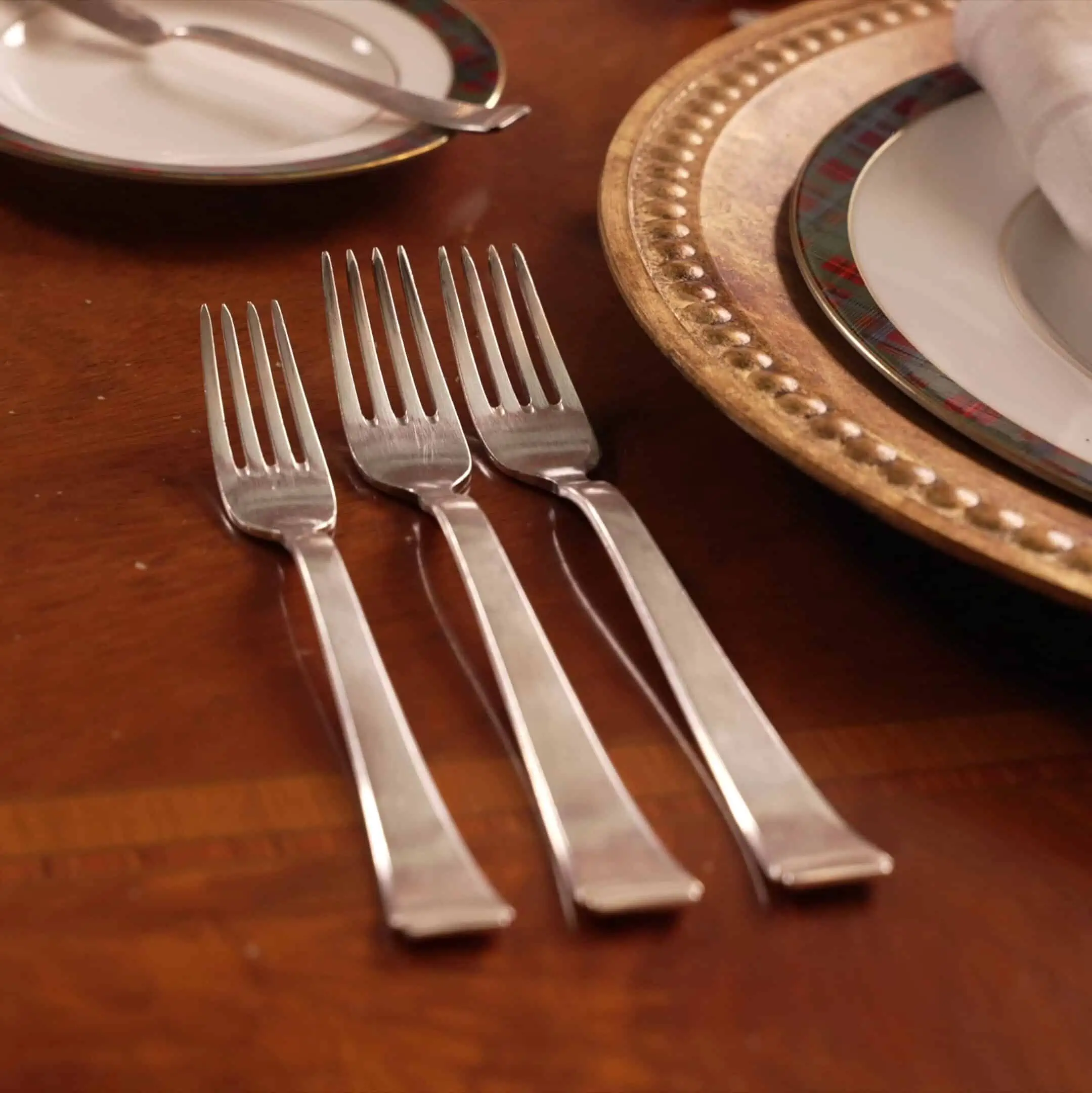
Use what’s available to you laid out at a place setting. So, if there’s a steak knife, by all means, go ahead and use it. If there is a special seafood fork, try to incorporate it. If you’re not sure how to use it, ask if someone can show you.
Also, do eat from the outside in because you don’t, for example, want to use your big fork for your salad course and then your small salad fork for your main course.
14. Request New Silverware When Needed
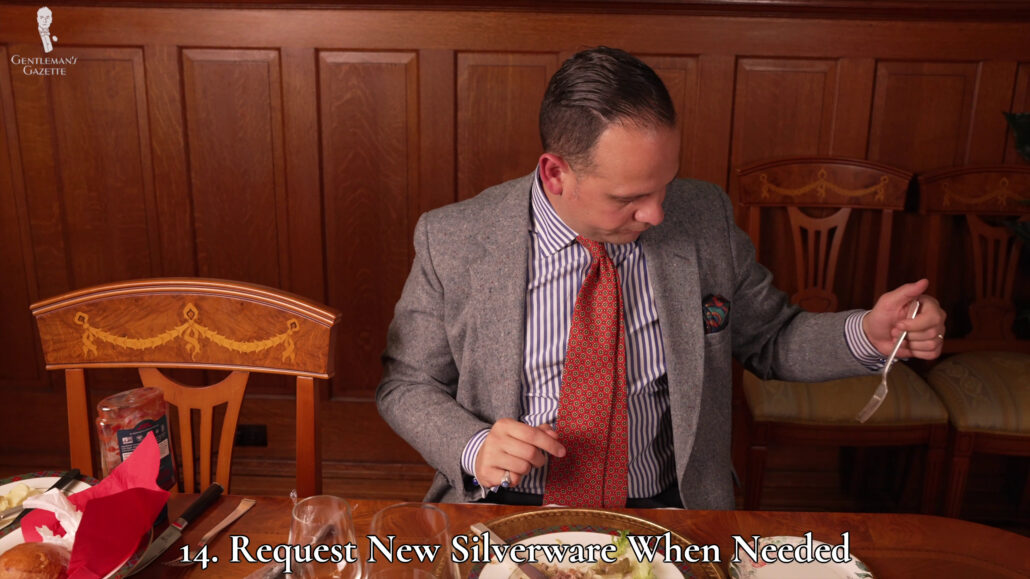
Do request new silverware if it drops on the floor or it is taken away with your plate, and you find yourself without an extra fork or extra knife.
15. Don’t Make Excessive Noise With Silverware
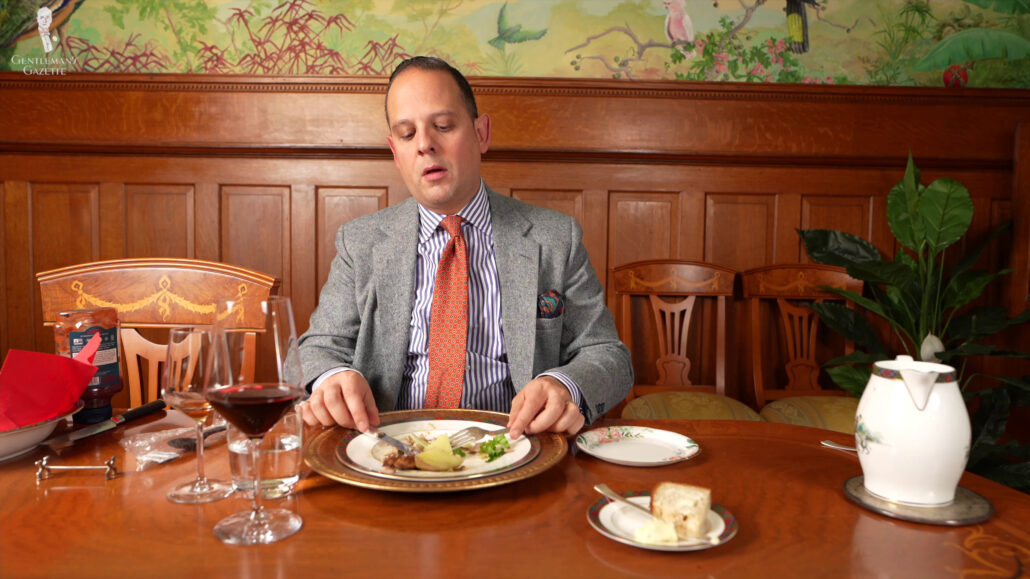
Don’t clatter or make extensive noise when you pick up or put down your silverware. It’s just annoying to others around you.
16. Use Communal Flatware When Available
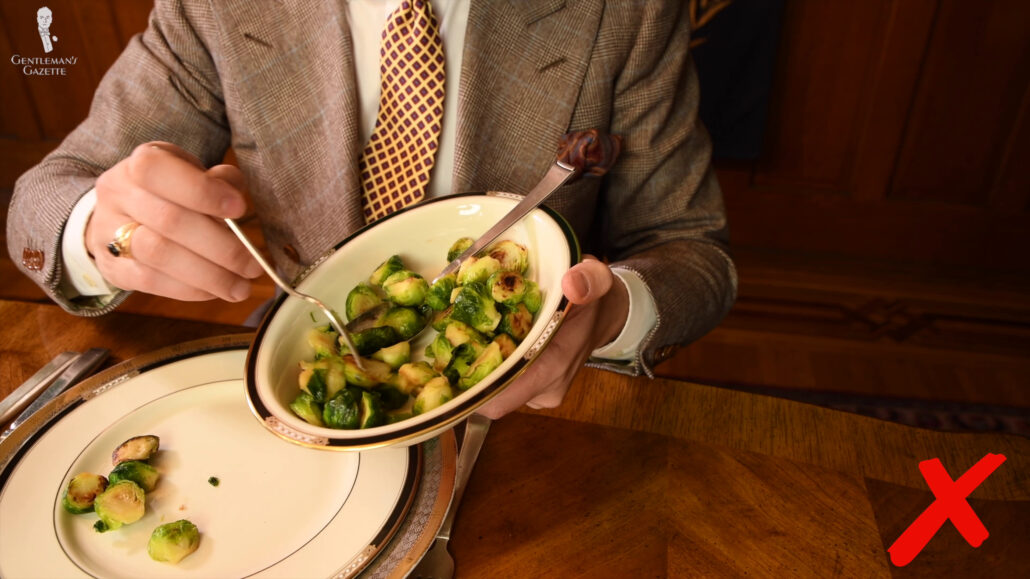
Don’t use your silverware in lieu of communal flatware. The food-served community typically will have serving utensils. If it doesn’t then you can use a clean utensil that you have once, but don’t ever put a fork into your mouth and then use it to take food from a communal platter.
17. Rest Used Utensils On Your Plate
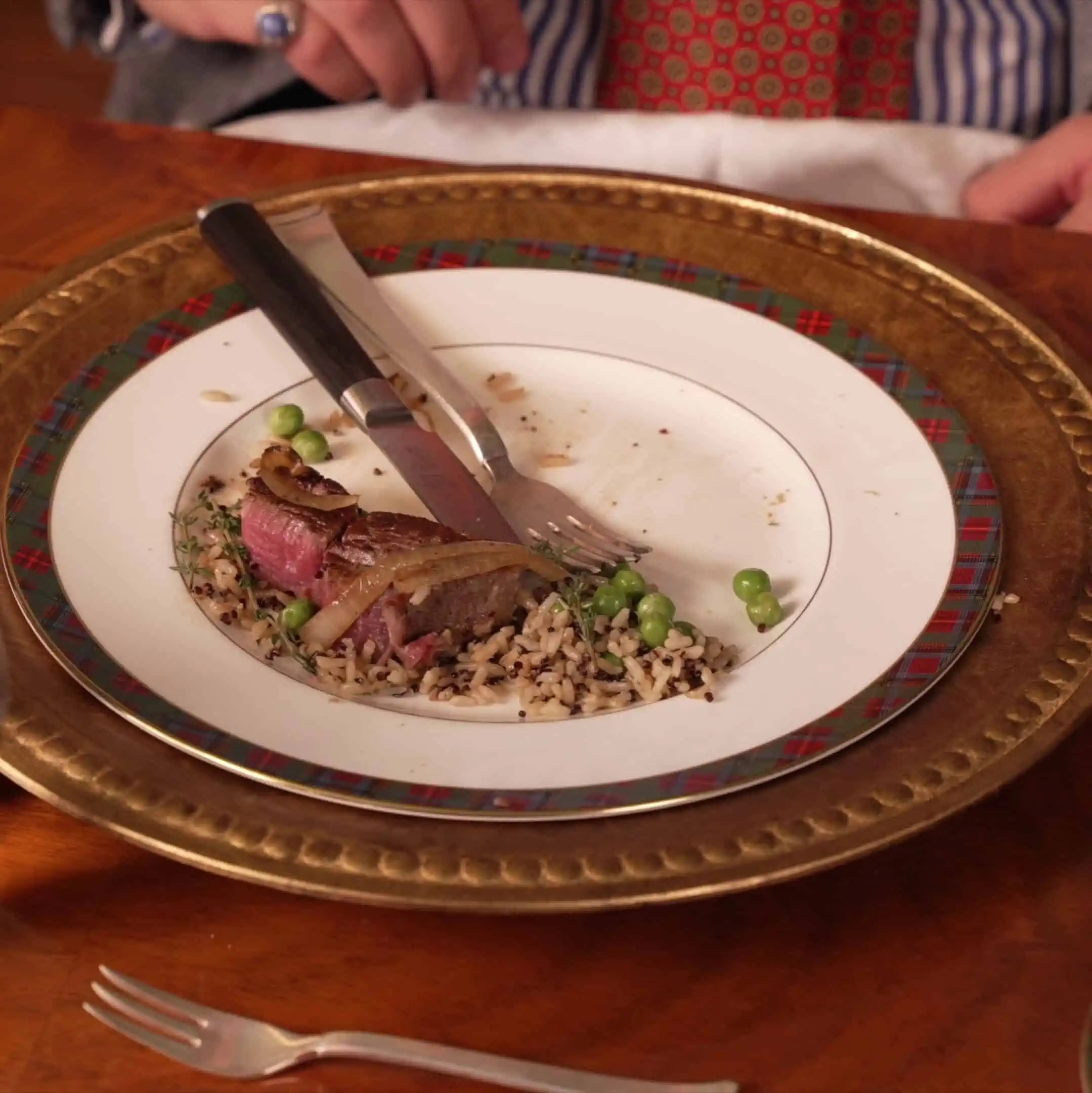
Try to not to stain the tablecloth. Sometimes, you may also find a knife rest, so that’s what this should be used for.
18. Don’t Leave Half-Eaten Food On Fork
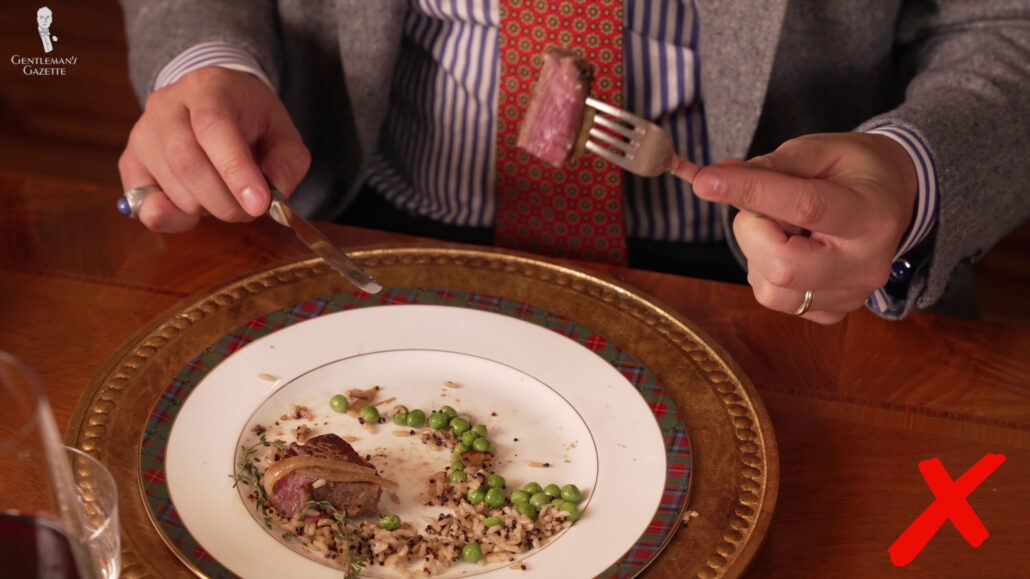
In that same vein, don’t take a large piece of meat on your fork and just bite off of it. It just looks very raw and animalistic.
19. Don’t Gesture With Your Silverware
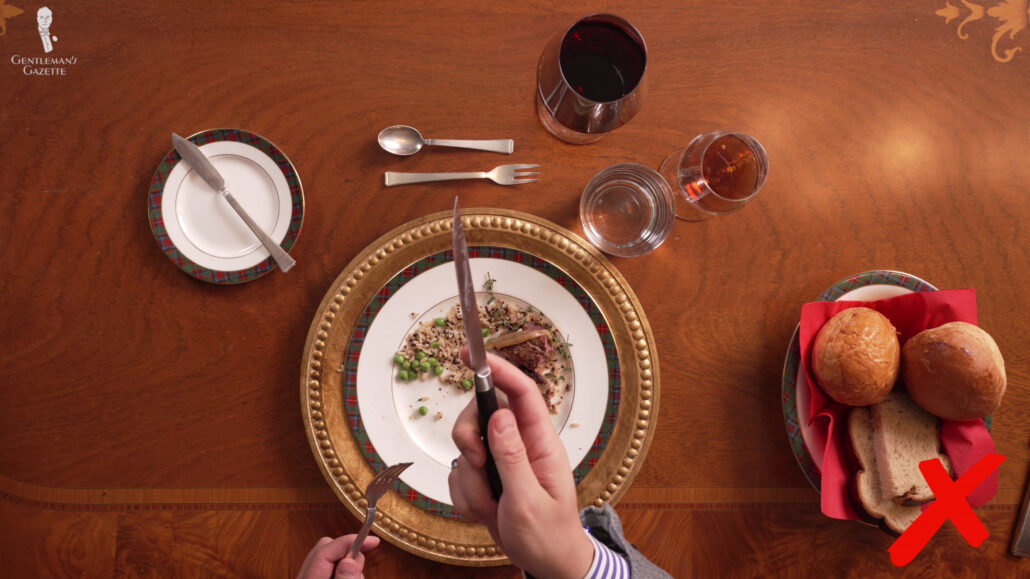
Don’t make gestures or point at people with your silverware. Again, it acts as an extension to your arms and, as such, you will have a much bigger impact that will look more extreme, and you might accidentally hit a wine glass. The wine will go all over the table, or you may hit someone and that’s just not something you want to encounter.
20. Allow Your Silverware To Be Taken Away
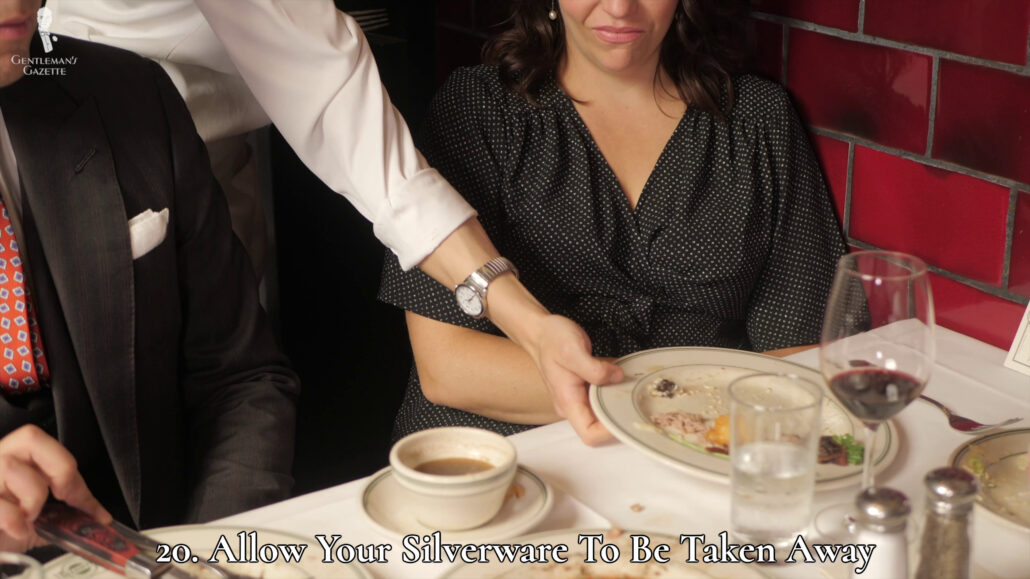
Do allow your silverware to be taken away with each course. No need to put dirty silverware onto the table or soil the tablecloth.
21. Don’t Hang Onto Your Silverware
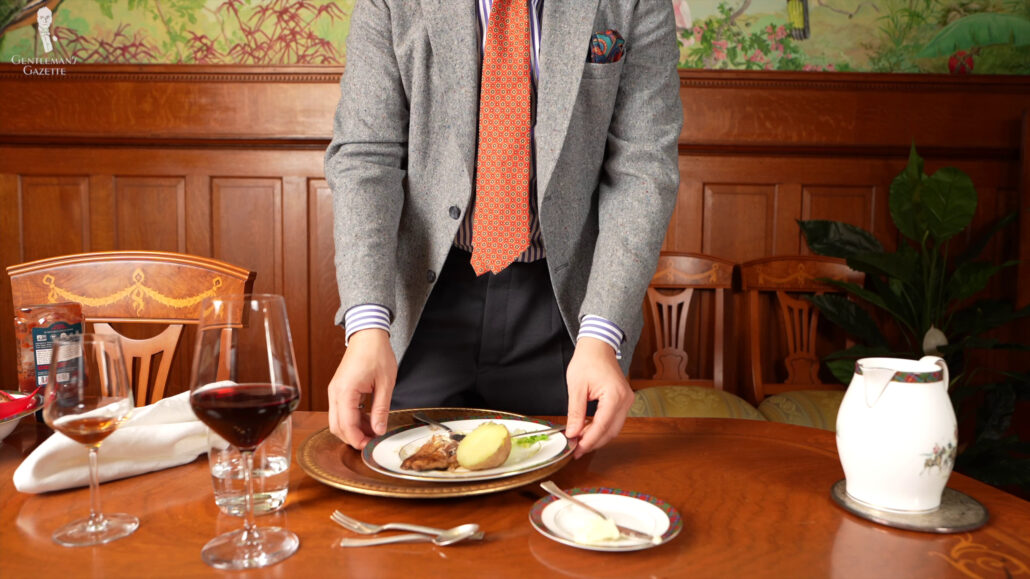
In that same vein, don’t try to unnecessarily hang on to your silverware, so there’s more space in a dishwasher later on, or don’t try to clean it with your napkin in between.
22. Keep Leftover Sauce On Your Plate
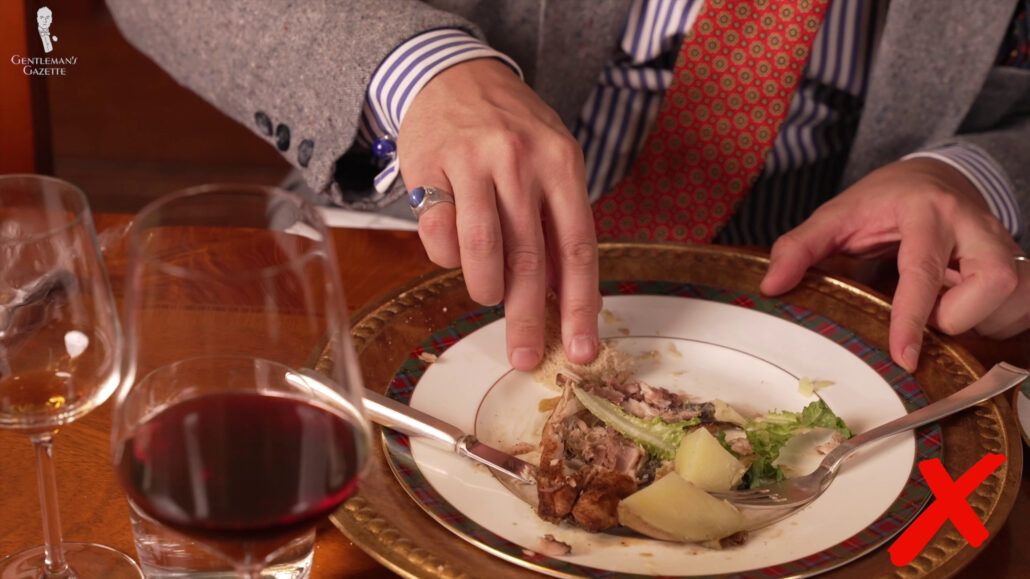
Don’t scrape left over sauce onto your knife or your fork, and try to shove it in your mouth, even though it’s really, really good.
In the same vein, don’t take a piece of bread and clean off your plate at a nice restaurant. And when there is sauce, you should only eat it with the food, so try to use the appropriate amount and don’t just overload your plate, so you’ll still have a sea of sauce when you’re all done with your food. That’s just wasteful and shows a lack of respect for the cook and the chef who made that food.
If you’re interested in more etiquette guides, or other things in that vein, please share with us in the comments.
Outfit Rundown
Today, I’m wearing a gray, Donegal tweed jacket, which is part of a suit, but I’m combining it with a navy pair of wool trousers that is nicely pleated. The jacket is No Name. The pants were made by Oxford.
The shirt is, I think, made-to-measure I forget by whom. It’s blue and white striped, I think, with an Albini fabric. It has French cuffs or double cuffs that I wear with blue and silver cufflinks that are made with lapis lazuli and sterling silver that is platinum coated. They’re by Fort Belvedere, and you can find them in our shop, just like the wool-silk pocket square that has tones of orange, green, and blue, which picks up the flecks in the jacket and other parts of my outfit.
The tie is made of printed English silk in an orangish red, kind of micro pattern. My shoes are interesting monk straps from Alton in Paris. They were custom stained for me, and I really liked the patina.
My socks are navy and khaki, two-tone stripe socks from Fort Belvedere that are ideal to be worn with khakis and blazers, but you can also combine them with navy pants and brown shoes, for example, just like I’m doing here.
Last but not least, I have a pinky ring with a synthetic star sapphire, two diamonds, and kind of a roughed-up surface, so it’s not a shiny metal surface.
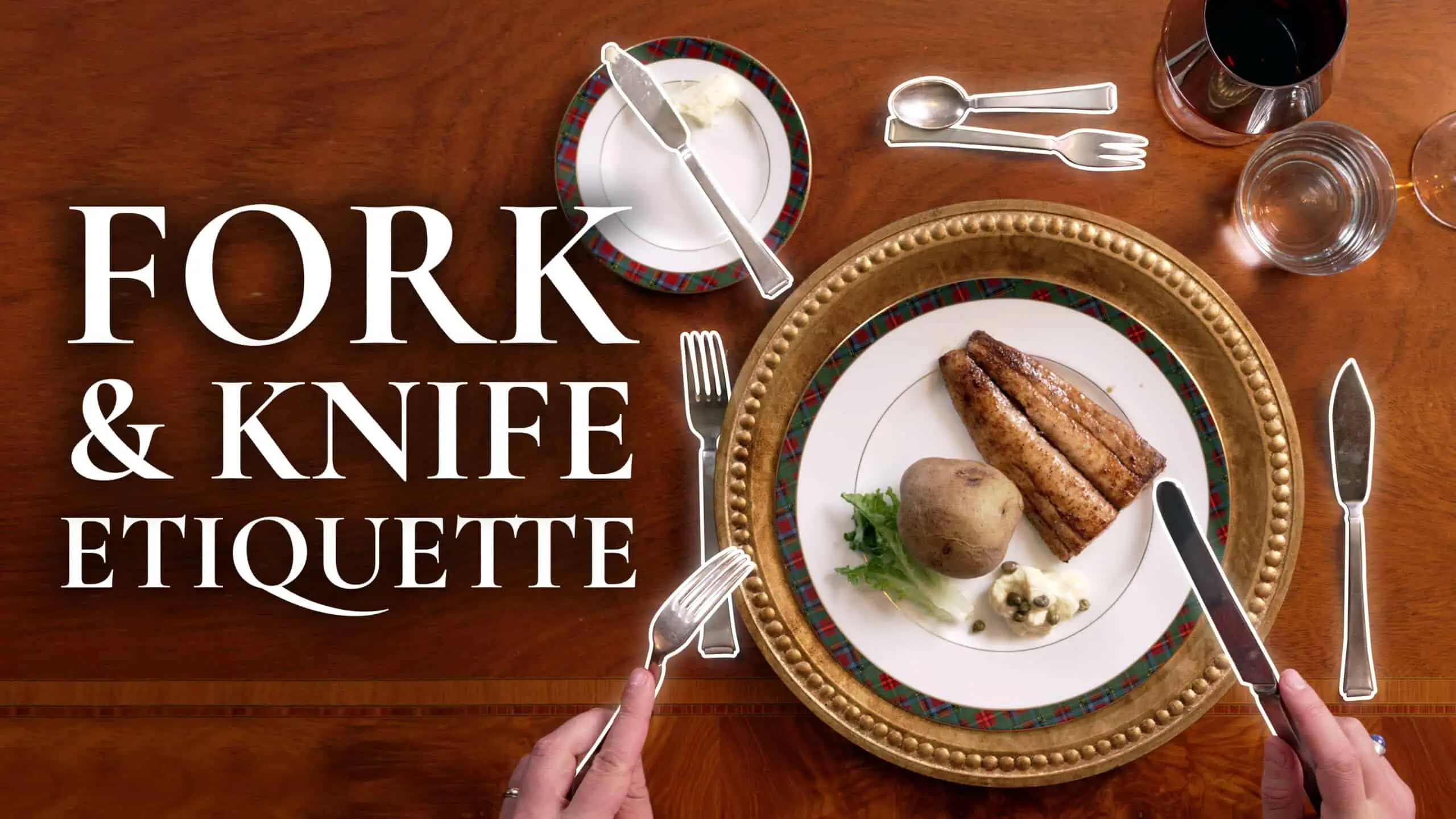
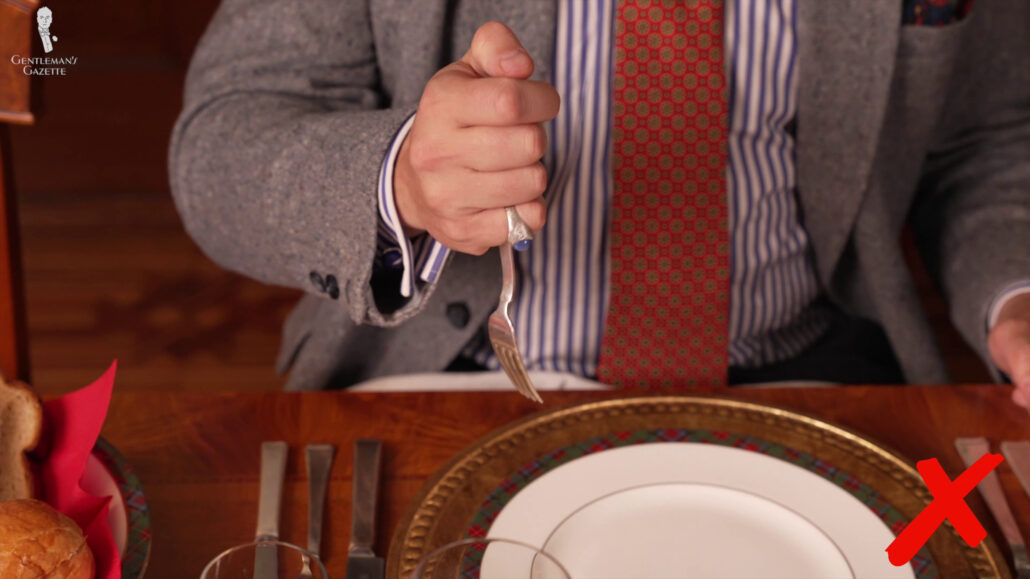
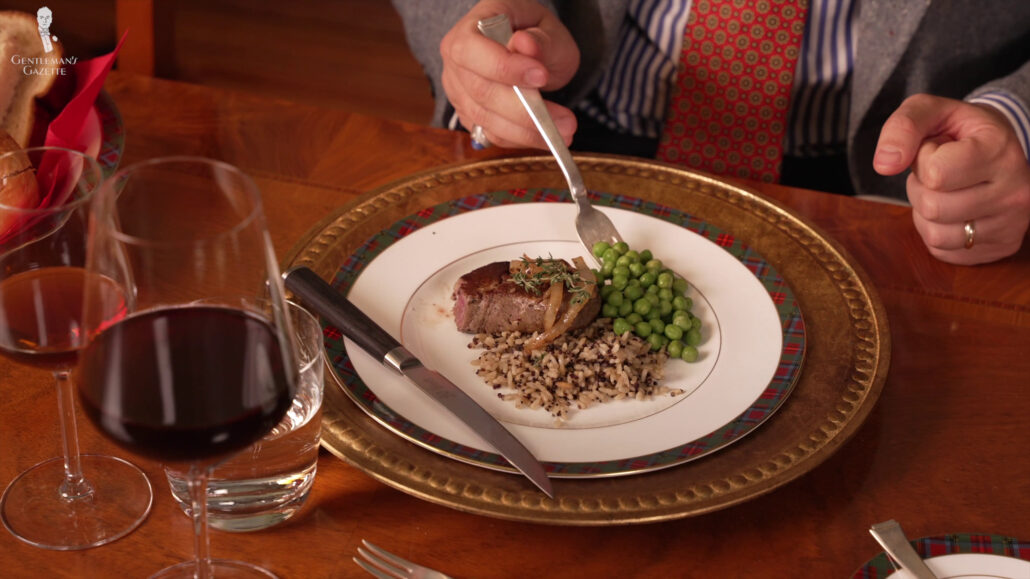
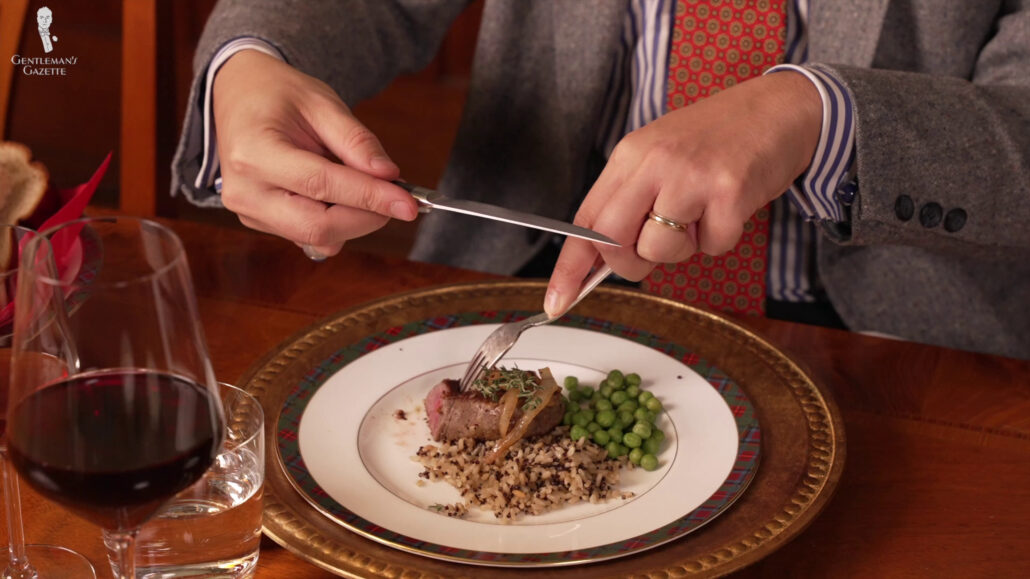
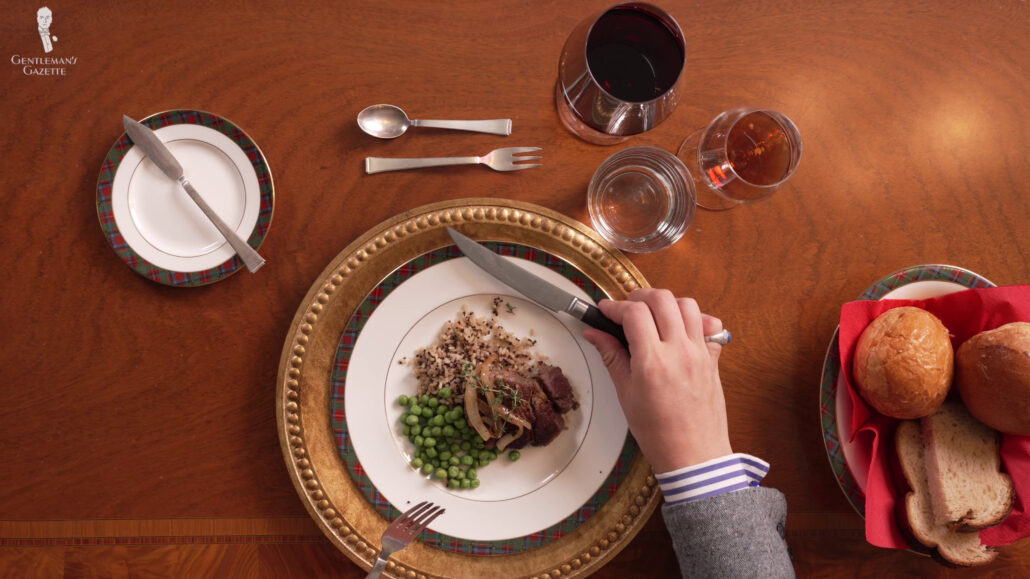
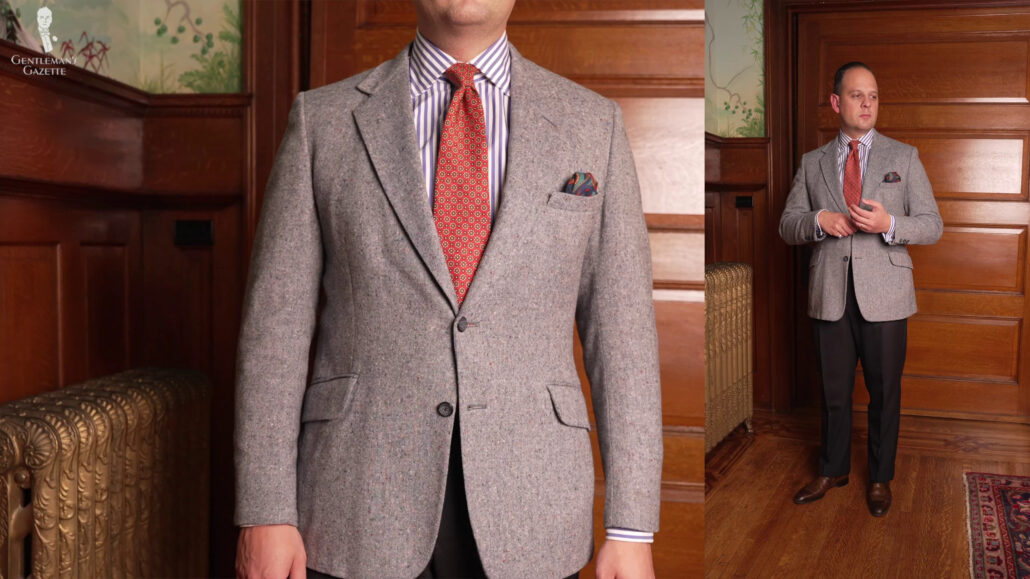
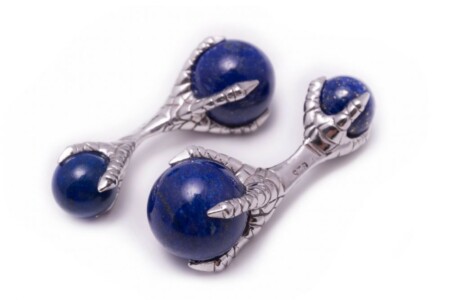
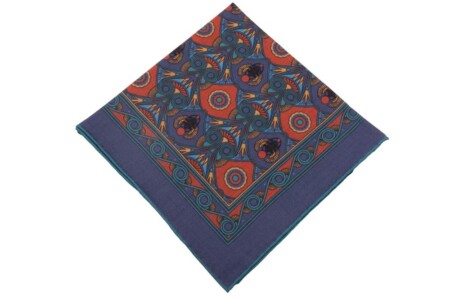
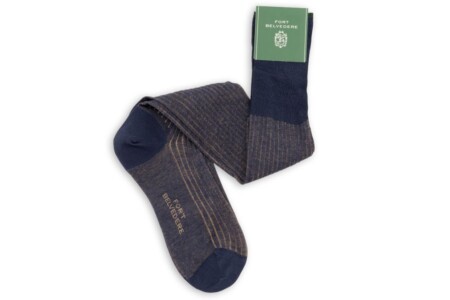
Interesting article, Sven.
Being left-handed, I have since my childhood eaten in the continental style without thinking about it.
Most Canadians I know use their silverware In British or French continental fashion. In fact, I can’t think of any Canadians I know who eat in the U.S. manner.
My wife and I like to cruise on Oceania ships. They have fish knives. Also, you only have the utensils you need for the course you are eating.
When we are having a party, we always use china dishes and silver flatware. My wife’s parents owned a rental yard. So we have service for more than 40 people.
Superb! Now, on to spoons. And, yes, indeed, more table etiquette videos by Sven, por favor. And thank you for doing what you do.
Thanks, David! Glad to hear we have your support.
Would be interested if you have a follow up video on eating potentially awkward foods eg Seafood paella where muscles and prawns have shells on still
Or dishes where meats still have bones (is it ever appropriate to eat a chicken drumstick with fingers?)
Shelling crabs and lobster properly?
Second that, particularly in regards to how Italians eat long pasta in a meal (as vastly distinct from how noodles are eaten in the PRC haha!)
It would certainly be an interesting topic to discuss those “problem” food items that don’t conform to standard fork & knife etiquette
Can’t believe that this post is necessary.
I was told that the switcheroo in American eating arose when the folks on the frontier ate. At first, they had no proper knives and forks and used their own knife as a double-use instrument. (The knife they used was the one they carried in a scabbard on their belt). Although it is not appealing now, the left hand held the portion of meat down while the hunting knife it the right hand cut off a portion after which the point of the knife was used to that the meat and transport it to the mouth. Proper silverware didn’t show up until other more important furnishings were aquired.
An interesting addition, thank you!
Fried chicken is always eaten by hand, especially in the South
Shell in dishes such as paella or Mussels in wine sauce are fair game. In fact, in Mussuls au vin you use the former shell to pick the mussel out of the current shell.
In the UK tines down IS the correct way to use a fork, however the fact that it is correct doesn’t mean that this is what people do. Personally I think the use of hands needs to be in context, certain specific meals require their use. Similarly French cheeses deserve to be eaten off a knife for the fullest appreciation. However eating cooked meals with hands whilst outdoors and ambulant is an abomination which has no place in civilised society and should result in a good thrashing.
To Darryl’s first point, I agree we need to make the distinction between what’s considered correct in polite society in a given country and what most people there actually do. I was raised on the UK style but my parents neglected to include the always-tines-down rule, so I only adopted it after learning about it in adulthood. I had a lengthy adjustment period for dealing with small particulates like rice, but I never looked back once I’d got the hang of it—to my eye, transferring food on a tines-down fork simply looks more elegant, because of the difference in arm and hand posture vs. tines-up. Tines-down also means you generally can’t load as much food on a given forkful, which fosters a more leisurely meal.
Thanks Rafael, for this explanation. I am born and bred in continental Europe and just say that you show all the intricacies of European dining style. I have two small additions:
1) on the British tines down at all times rule, there is one exception. If you eat cooked small green peas, have the tines point up and squash some peas with the fork, hoping they stick to the fork long enough to reach your mouth.
2) with a course that requires only one piece of cutlery, say soup, cake or icecream, you always have this spoon or fork in your right hand.
Another small comment: in many places in Europe it is considered inappropriate to have cutlery lying around on your plate while eating. You keep your knife in your hand.